Finance and Funding in Travel and Tourism Sector
VerifiedAdded on 2024/04/24
|40
|6021
|127
AI Summary
This report explores the importance of cost, volume, and profit analysis in decision-making for travel and tourism businesses. It delves into pricing methods, factors influencing profit, management accounting information, financial account interpretation, and funding sources for tourism development.
Contribute Materials
Your contribution can guide someone’s learning journey. Share your
documents today.
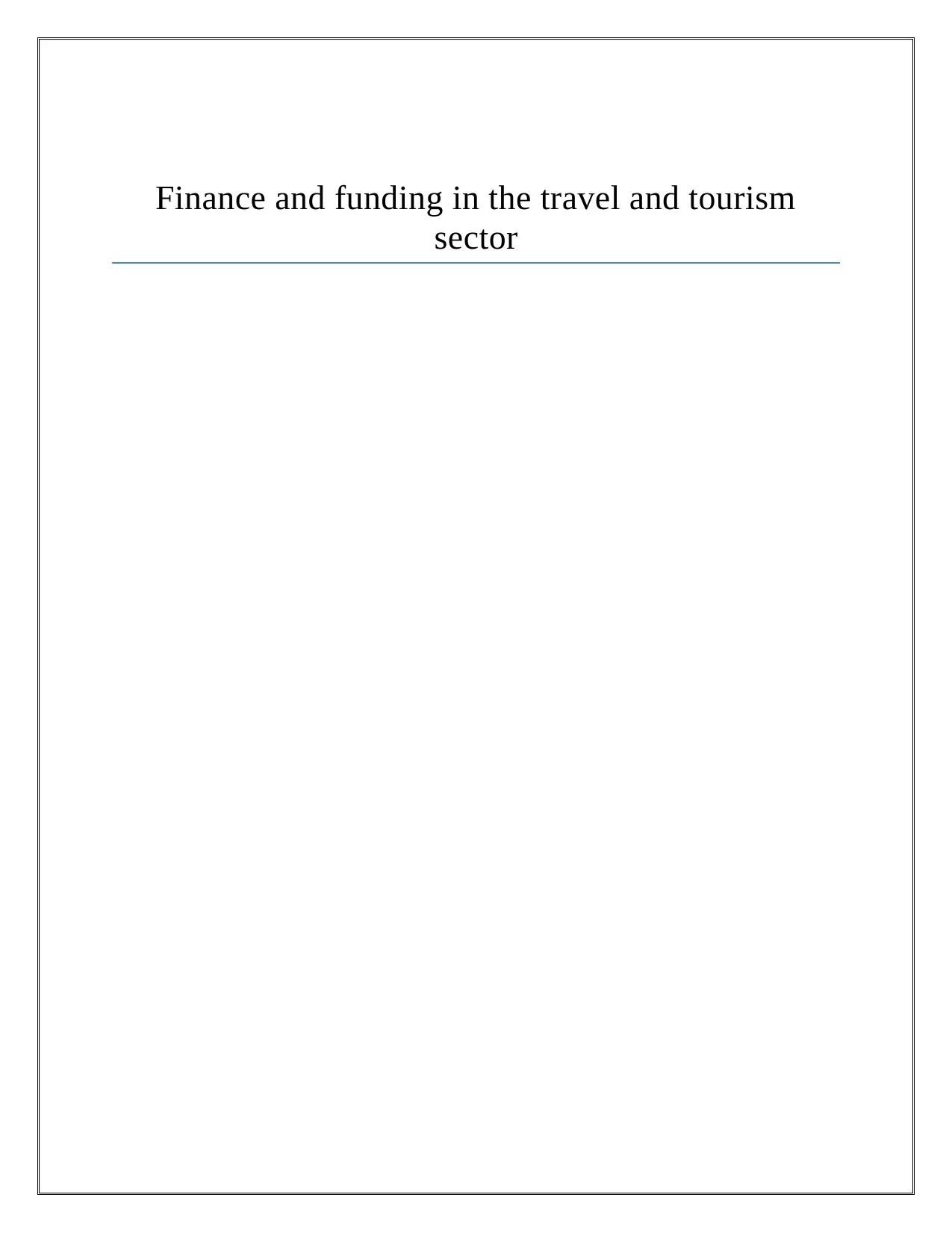
Finance and funding in the travel and tourism
sector
sector
Secure Best Marks with AI Grader
Need help grading? Try our AI Grader for instant feedback on your assignments.
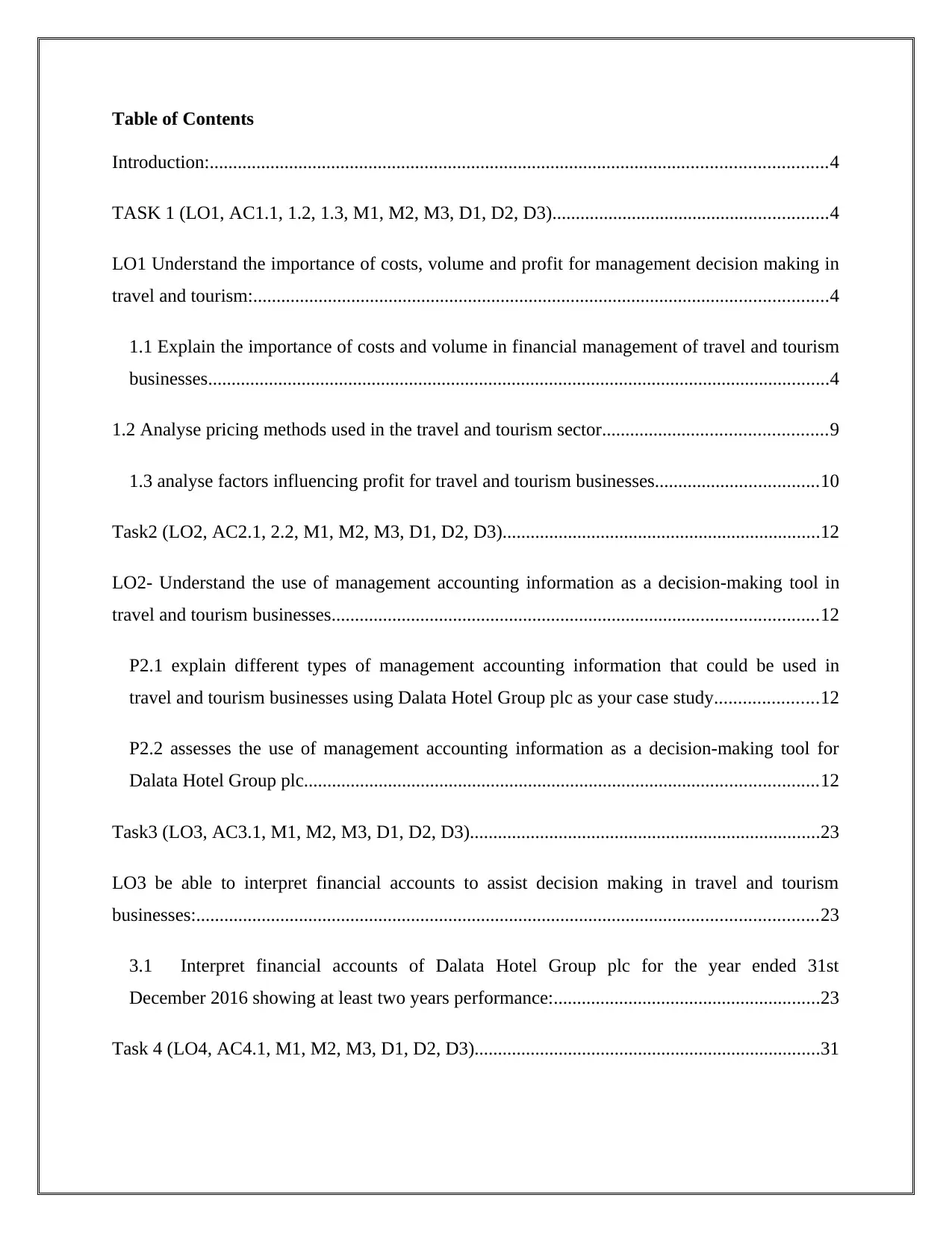
Table of Contents
Introduction:....................................................................................................................................4
TASK 1 (LO1, AC1.1, 1.2, 1.3, M1, M2, M3, D1, D2, D3)...........................................................4
LO1 Understand the importance of costs, volume and profit for management decision making in
travel and tourism:...........................................................................................................................4
1.1 Explain the importance of costs and volume in financial management of travel and tourism
businesses.....................................................................................................................................4
1.2 Analyse pricing methods used in the travel and tourism sector................................................9
1.3 analyse factors influencing profit for travel and tourism businesses...................................10
Task2 (LO2, AC2.1, 2.2, M1, M2, M3, D1, D2, D3)....................................................................12
LO2- Understand the use of management accounting information as a decision-making tool in
travel and tourism businesses........................................................................................................12
P2.1 explain different types of management accounting information that could be used in
travel and tourism businesses using Dalata Hotel Group plc as your case study......................12
P2.2 assesses the use of management accounting information as a decision-making tool for
Dalata Hotel Group plc..............................................................................................................12
Task3 (LO3, AC3.1, M1, M2, M3, D1, D2, D3)...........................................................................23
LO3 be able to interpret financial accounts to assist decision making in travel and tourism
businesses:.....................................................................................................................................23
3.1 Interpret financial accounts of Dalata Hotel Group plc for the year ended 31st
December 2016 showing at least two years performance:.........................................................23
Task 4 (LO4, AC4.1, M1, M2, M3, D1, D2, D3)..........................................................................31
Introduction:....................................................................................................................................4
TASK 1 (LO1, AC1.1, 1.2, 1.3, M1, M2, M3, D1, D2, D3)...........................................................4
LO1 Understand the importance of costs, volume and profit for management decision making in
travel and tourism:...........................................................................................................................4
1.1 Explain the importance of costs and volume in financial management of travel and tourism
businesses.....................................................................................................................................4
1.2 Analyse pricing methods used in the travel and tourism sector................................................9
1.3 analyse factors influencing profit for travel and tourism businesses...................................10
Task2 (LO2, AC2.1, 2.2, M1, M2, M3, D1, D2, D3)....................................................................12
LO2- Understand the use of management accounting information as a decision-making tool in
travel and tourism businesses........................................................................................................12
P2.1 explain different types of management accounting information that could be used in
travel and tourism businesses using Dalata Hotel Group plc as your case study......................12
P2.2 assesses the use of management accounting information as a decision-making tool for
Dalata Hotel Group plc..............................................................................................................12
Task3 (LO3, AC3.1, M1, M2, M3, D1, D2, D3)...........................................................................23
LO3 be able to interpret financial accounts to assist decision making in travel and tourism
businesses:.....................................................................................................................................23
3.1 Interpret financial accounts of Dalata Hotel Group plc for the year ended 31st
December 2016 showing at least two years performance:.........................................................23
Task 4 (LO4, AC4.1, M1, M2, M3, D1, D2, D3)..........................................................................31
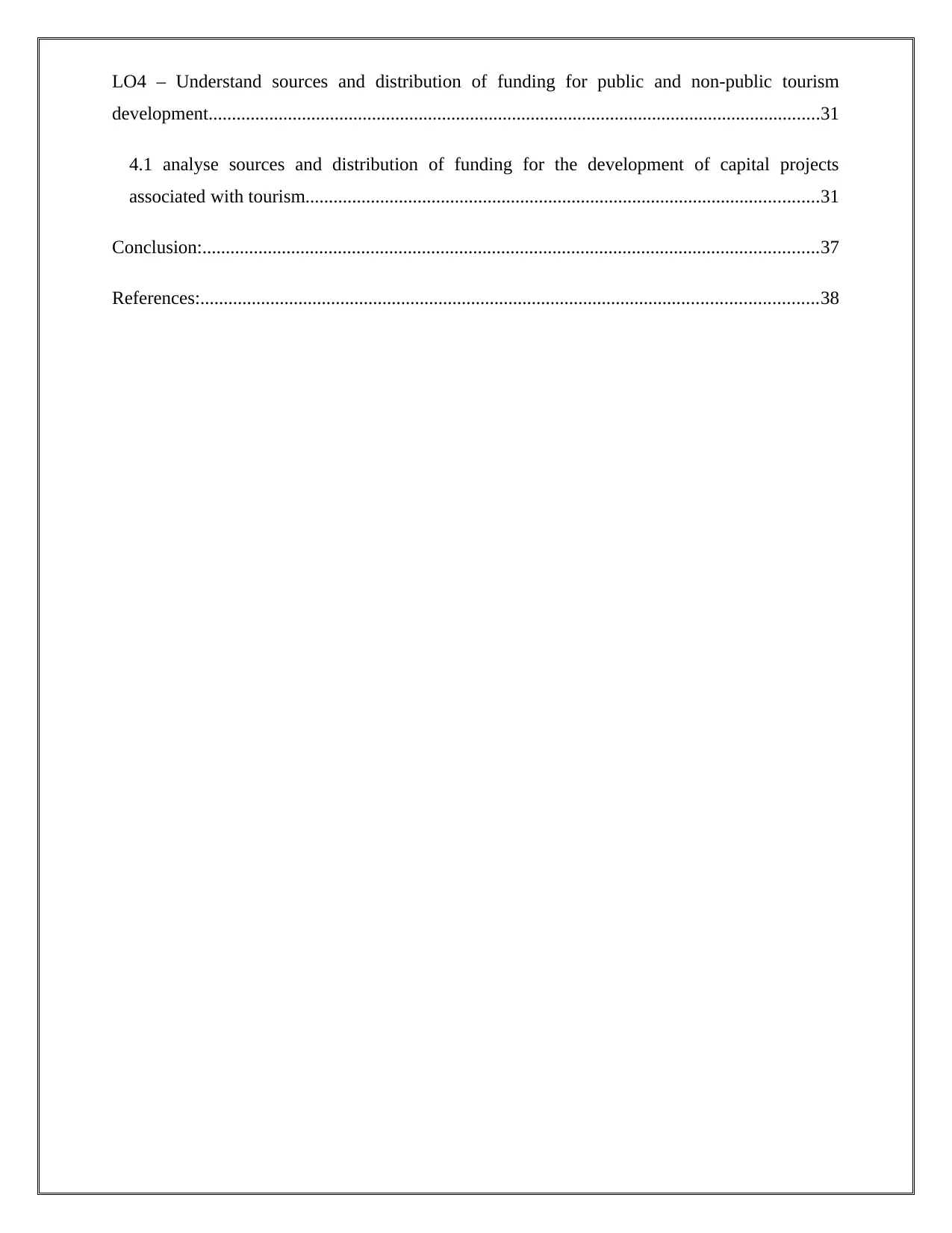
LO4 – Understand sources and distribution of funding for public and non-public tourism
development...................................................................................................................................31
4.1 analyse sources and distribution of funding for the development of capital projects
associated with tourism..............................................................................................................31
Conclusion:....................................................................................................................................37
References:....................................................................................................................................38
development...................................................................................................................................31
4.1 analyse sources and distribution of funding for the development of capital projects
associated with tourism..............................................................................................................31
Conclusion:....................................................................................................................................37
References:....................................................................................................................................38
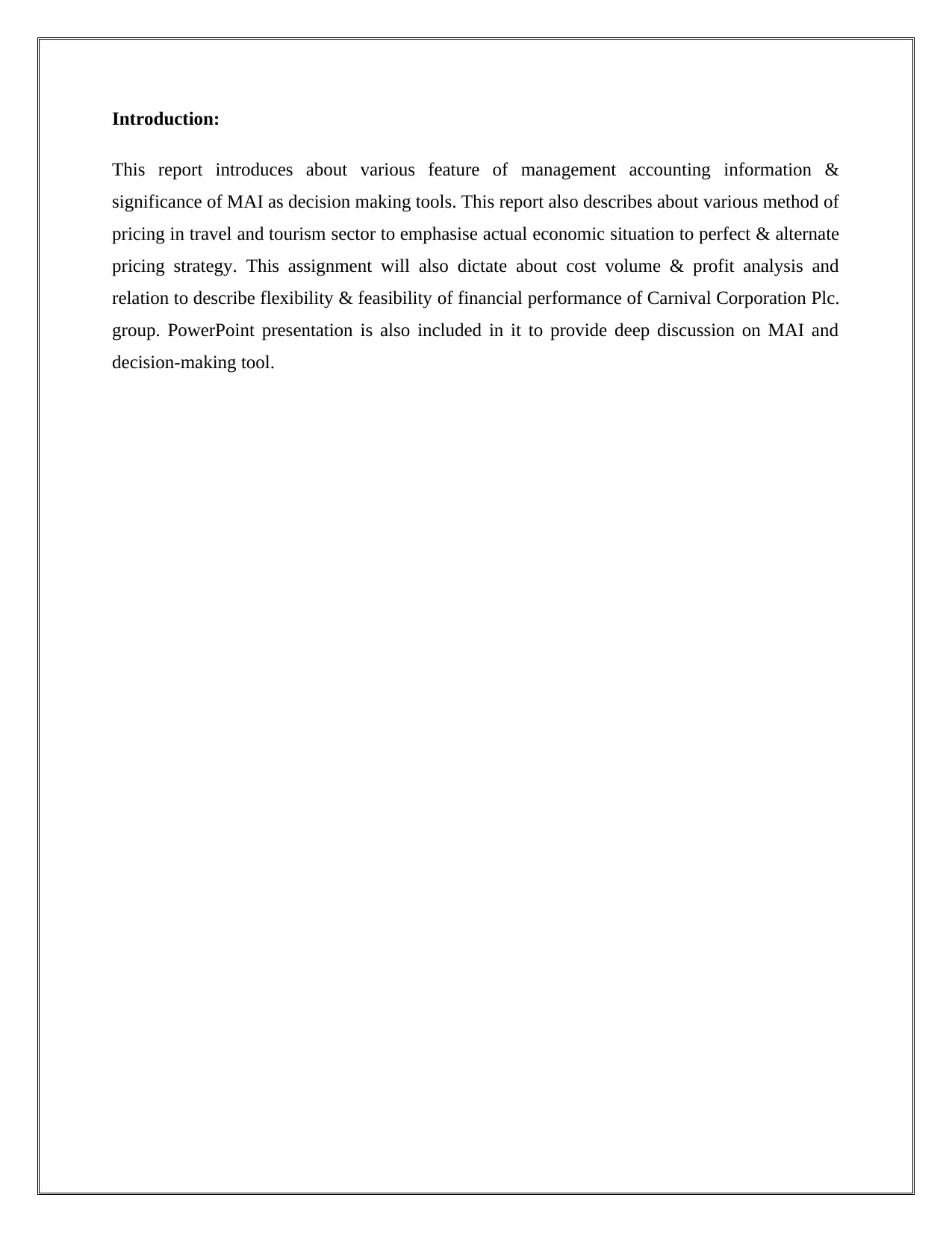
Introduction:
This report introduces about various feature of management accounting information &
significance of MAI as decision making tools. This report also describes about various method of
pricing in travel and tourism sector to emphasise actual economic situation to perfect & alternate
pricing strategy. This assignment will also dictate about cost volume & profit analysis and
relation to describe flexibility & feasibility of financial performance of Carnival Corporation Plc.
group. PowerPoint presentation is also included in it to provide deep discussion on MAI and
decision-making tool.
This report introduces about various feature of management accounting information &
significance of MAI as decision making tools. This report also describes about various method of
pricing in travel and tourism sector to emphasise actual economic situation to perfect & alternate
pricing strategy. This assignment will also dictate about cost volume & profit analysis and
relation to describe flexibility & feasibility of financial performance of Carnival Corporation Plc.
group. PowerPoint presentation is also included in it to provide deep discussion on MAI and
decision-making tool.
Secure Best Marks with AI Grader
Need help grading? Try our AI Grader for instant feedback on your assignments.
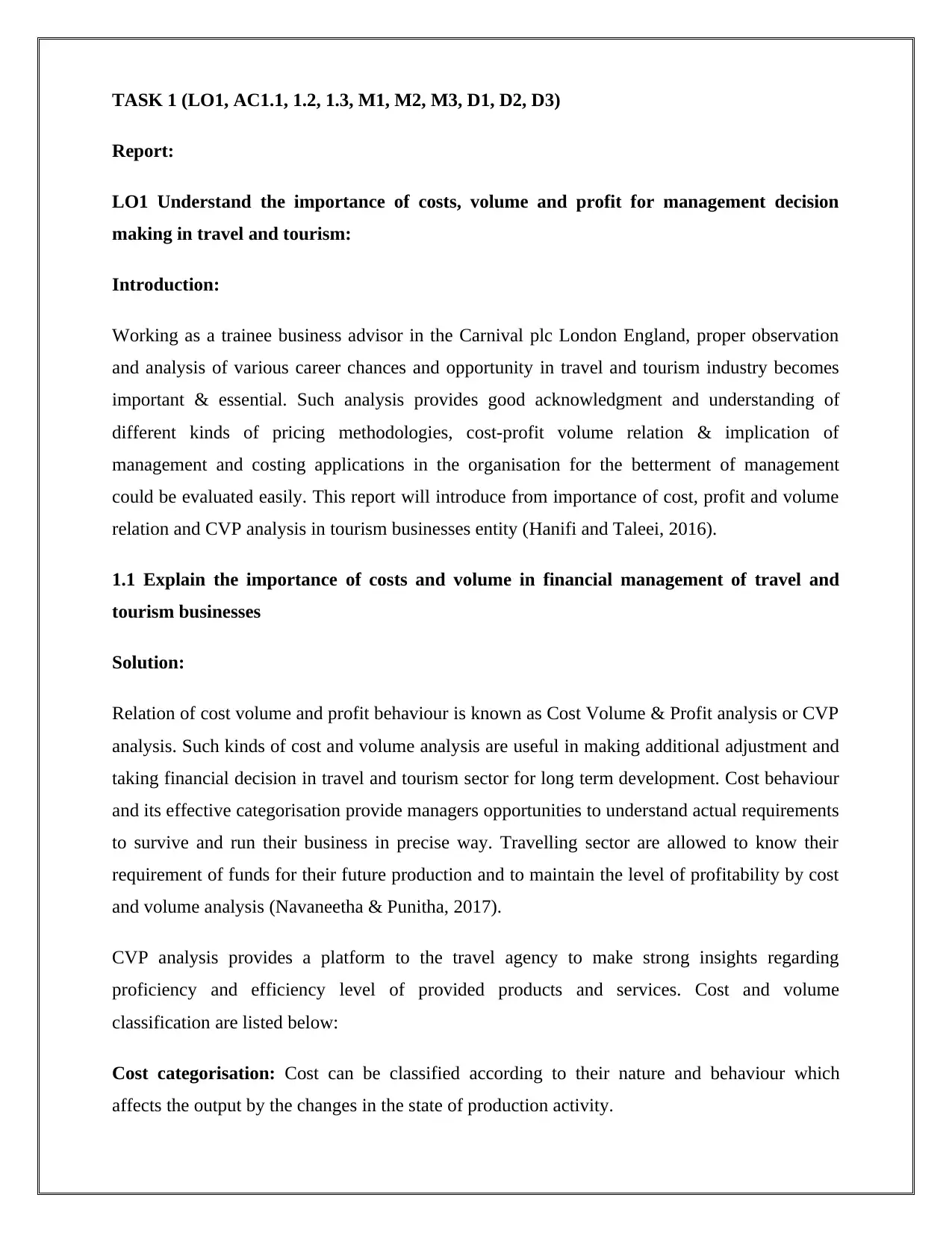
TASK 1 (LO1, AC1.1, 1.2, 1.3, M1, M2, M3, D1, D2, D3)
Report:
LO1 Understand the importance of costs, volume and profit for management decision
making in travel and tourism:
Introduction:
Working as a trainee business advisor in the Carnival plc London England, proper observation
and analysis of various career chances and opportunity in travel and tourism industry becomes
important & essential. Such analysis provides good acknowledgment and understanding of
different kinds of pricing methodologies, cost-profit volume relation & implication of
management and costing applications in the organisation for the betterment of management
could be evaluated easily. This report will introduce from importance of cost, profit and volume
relation and CVP analysis in tourism businesses entity (Hanifi and Taleei, 2016).
1.1 Explain the importance of costs and volume in financial management of travel and
tourism businesses
Solution:
Relation of cost volume and profit behaviour is known as Cost Volume & Profit analysis or CVP
analysis. Such kinds of cost and volume analysis are useful in making additional adjustment and
taking financial decision in travel and tourism sector for long term development. Cost behaviour
and its effective categorisation provide managers opportunities to understand actual requirements
to survive and run their business in precise way. Travelling sector are allowed to know their
requirement of funds for their future production and to maintain the level of profitability by cost
and volume analysis (Navaneetha & Punitha, 2017).
CVP analysis provides a platform to the travel agency to make strong insights regarding
proficiency and efficiency level of provided products and services. Cost and volume
classification are listed below:
Cost categorisation: Cost can be classified according to their nature and behaviour which
affects the output by the changes in the state of production activity.
Report:
LO1 Understand the importance of costs, volume and profit for management decision
making in travel and tourism:
Introduction:
Working as a trainee business advisor in the Carnival plc London England, proper observation
and analysis of various career chances and opportunity in travel and tourism industry becomes
important & essential. Such analysis provides good acknowledgment and understanding of
different kinds of pricing methodologies, cost-profit volume relation & implication of
management and costing applications in the organisation for the betterment of management
could be evaluated easily. This report will introduce from importance of cost, profit and volume
relation and CVP analysis in tourism businesses entity (Hanifi and Taleei, 2016).
1.1 Explain the importance of costs and volume in financial management of travel and
tourism businesses
Solution:
Relation of cost volume and profit behaviour is known as Cost Volume & Profit analysis or CVP
analysis. Such kinds of cost and volume analysis are useful in making additional adjustment and
taking financial decision in travel and tourism sector for long term development. Cost behaviour
and its effective categorisation provide managers opportunities to understand actual requirements
to survive and run their business in precise way. Travelling sector are allowed to know their
requirement of funds for their future production and to maintain the level of profitability by cost
and volume analysis (Navaneetha & Punitha, 2017).
CVP analysis provides a platform to the travel agency to make strong insights regarding
proficiency and efficiency level of provided products and services. Cost and volume
classification are listed below:
Cost categorisation: Cost can be classified according to their nature and behaviour which
affects the output by the changes in the state of production activity.

Fixed Cost: fixed cost are those cost that remain constant with the irrespective changes in the
level of business activity but sometimes changes would be occurred due to rises in the business
activities as an outcome of inflation. Generally it is remain unchanged in short run scale of
economy such as business rent, salaries of staffs, insurance, business exchange rates &
administrative or factory expenses (Navaneetha & Punitha, 2017).
Cost behaviour: fixed assets:
Fixed cost is basically used for a level of production output but if output increases due to
increment in sales beyond the range of requirement some of the level of fixed cost would meet
new output level. In the case of short run scale of economy, such as rent of the business as fixed
cost is used, it will remain constant until additional changes occurred
Figure 1: fixed cost
(Source: Kim, 2015).
Variable Cost:
Variable cost varies changes due to fluctuation occurred in the production level of activity. When
changes happened in the level of production or sales volume, variable cost is fluctuated in the
same proportion of sales volume. Changes invariable cost like; telephone call; charges, cost of
purchasing goods.
Cost behaviour- variable cost: -
level of business activity but sometimes changes would be occurred due to rises in the business
activities as an outcome of inflation. Generally it is remain unchanged in short run scale of
economy such as business rent, salaries of staffs, insurance, business exchange rates &
administrative or factory expenses (Navaneetha & Punitha, 2017).
Cost behaviour: fixed assets:
Fixed cost is basically used for a level of production output but if output increases due to
increment in sales beyond the range of requirement some of the level of fixed cost would meet
new output level. In the case of short run scale of economy, such as rent of the business as fixed
cost is used, it will remain constant until additional changes occurred
Figure 1: fixed cost
(Source: Kim, 2015).
Variable Cost:
Variable cost varies changes due to fluctuation occurred in the production level of activity. When
changes happened in the level of production or sales volume, variable cost is fluctuated in the
same proportion of sales volume. Changes invariable cost like; telephone call; charges, cost of
purchasing goods.
Cost behaviour- variable cost: -
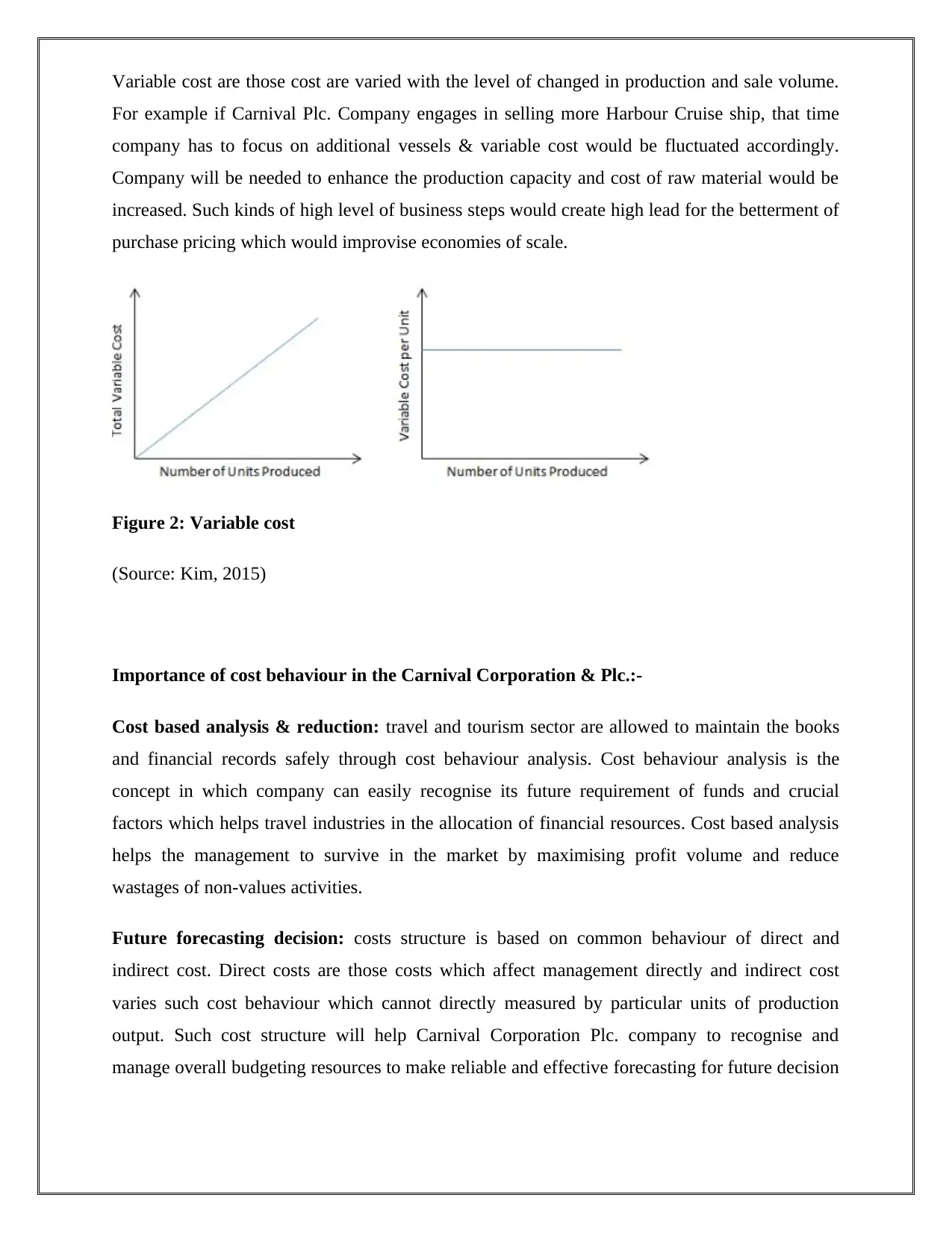
Variable cost are those cost are varied with the level of changed in production and sale volume.
For example if Carnival Plc. Company engages in selling more Harbour Cruise ship, that time
company has to focus on additional vessels & variable cost would be fluctuated accordingly.
Company will be needed to enhance the production capacity and cost of raw material would be
increased. Such kinds of high level of business steps would create high lead for the betterment of
purchase pricing which would improvise economies of scale.
Figure 2: Variable cost
(Source: Kim, 2015)
Importance of cost behaviour in the Carnival Corporation & Plc.:-
Cost based analysis & reduction: travel and tourism sector are allowed to maintain the books
and financial records safely through cost behaviour analysis. Cost behaviour analysis is the
concept in which company can easily recognise its future requirement of funds and crucial
factors which helps travel industries in the allocation of financial resources. Cost based analysis
helps the management to survive in the market by maximising profit volume and reduce
wastages of non-values activities.
Future forecasting decision: costs structure is based on common behaviour of direct and
indirect cost. Direct costs are those costs which affect management directly and indirect cost
varies such cost behaviour which cannot directly measured by particular units of production
output. Such cost structure will help Carnival Corporation Plc. company to recognise and
manage overall budgeting resources to make reliable and effective forecasting for future decision
For example if Carnival Plc. Company engages in selling more Harbour Cruise ship, that time
company has to focus on additional vessels & variable cost would be fluctuated accordingly.
Company will be needed to enhance the production capacity and cost of raw material would be
increased. Such kinds of high level of business steps would create high lead for the betterment of
purchase pricing which would improvise economies of scale.
Figure 2: Variable cost
(Source: Kim, 2015)
Importance of cost behaviour in the Carnival Corporation & Plc.:-
Cost based analysis & reduction: travel and tourism sector are allowed to maintain the books
and financial records safely through cost behaviour analysis. Cost behaviour analysis is the
concept in which company can easily recognise its future requirement of funds and crucial
factors which helps travel industries in the allocation of financial resources. Cost based analysis
helps the management to survive in the market by maximising profit volume and reduce
wastages of non-values activities.
Future forecasting decision: costs structure is based on common behaviour of direct and
indirect cost. Direct costs are those costs which affect management directly and indirect cost
varies such cost behaviour which cannot directly measured by particular units of production
output. Such cost structure will help Carnival Corporation Plc. company to recognise and
manage overall budgeting resources to make reliable and effective forecasting for future decision
Paraphrase This Document
Need a fresh take? Get an instant paraphrase of this document with our AI Paraphraser
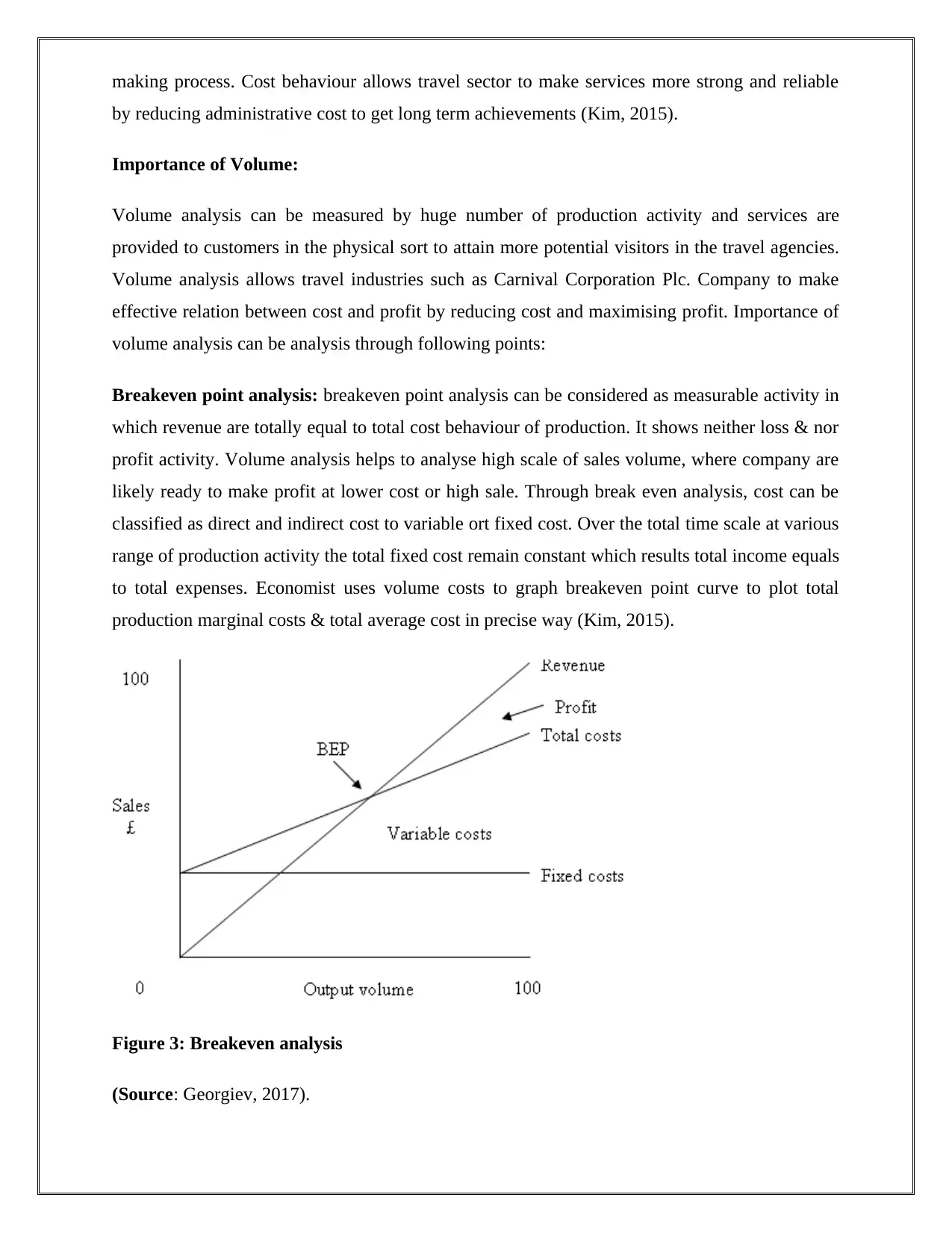
making process. Cost behaviour allows travel sector to make services more strong and reliable
by reducing administrative cost to get long term achievements (Kim, 2015).
Importance of Volume:
Volume analysis can be measured by huge number of production activity and services are
provided to customers in the physical sort to attain more potential visitors in the travel agencies.
Volume analysis allows travel industries such as Carnival Corporation Plc. Company to make
effective relation between cost and profit by reducing cost and maximising profit. Importance of
volume analysis can be analysis through following points:
Breakeven point analysis: breakeven point analysis can be considered as measurable activity in
which revenue are totally equal to total cost behaviour of production. It shows neither loss & nor
profit activity. Volume analysis helps to analyse high scale of sales volume, where company are
likely ready to make profit at lower cost or high sale. Through break even analysis, cost can be
classified as direct and indirect cost to variable ort fixed cost. Over the total time scale at various
range of production activity the total fixed cost remain constant which results total income equals
to total expenses. Economist uses volume costs to graph breakeven point curve to plot total
production marginal costs & total average cost in precise way (Kim, 2015).
Figure 3: Breakeven analysis
(Source: Georgiev, 2017).
by reducing administrative cost to get long term achievements (Kim, 2015).
Importance of Volume:
Volume analysis can be measured by huge number of production activity and services are
provided to customers in the physical sort to attain more potential visitors in the travel agencies.
Volume analysis allows travel industries such as Carnival Corporation Plc. Company to make
effective relation between cost and profit by reducing cost and maximising profit. Importance of
volume analysis can be analysis through following points:
Breakeven point analysis: breakeven point analysis can be considered as measurable activity in
which revenue are totally equal to total cost behaviour of production. It shows neither loss & nor
profit activity. Volume analysis helps to analyse high scale of sales volume, where company are
likely ready to make profit at lower cost or high sale. Through break even analysis, cost can be
classified as direct and indirect cost to variable ort fixed cost. Over the total time scale at various
range of production activity the total fixed cost remain constant which results total income equals
to total expenses. Economist uses volume costs to graph breakeven point curve to plot total
production marginal costs & total average cost in precise way (Kim, 2015).
Figure 3: Breakeven analysis
(Source: Georgiev, 2017).
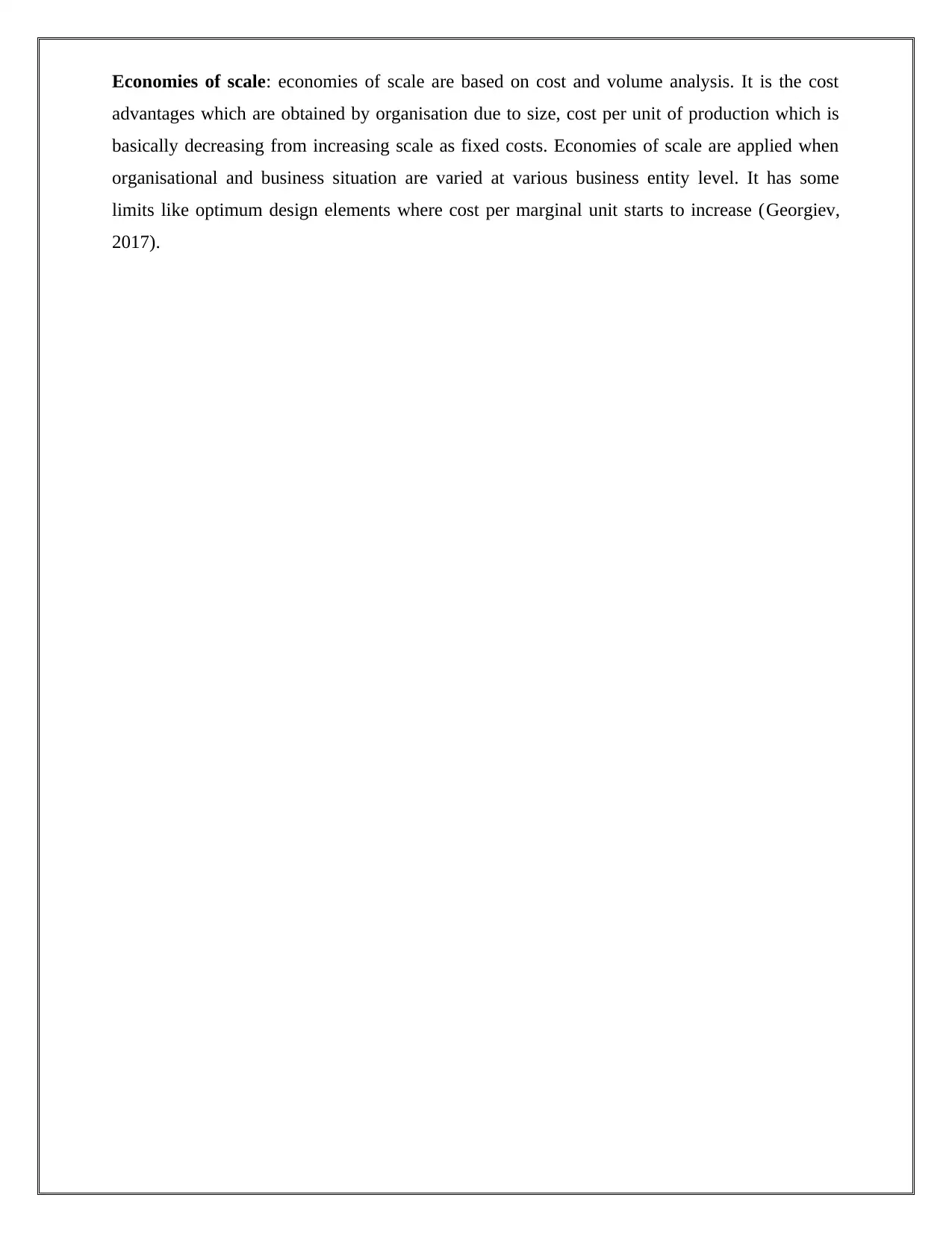
Economies of scale: economies of scale are based on cost and volume analysis. It is the cost
advantages which are obtained by organisation due to size, cost per unit of production which is
basically decreasing from increasing scale as fixed costs. Economies of scale are applied when
organisational and business situation are varied at various business entity level. It has some
limits like optimum design elements where cost per marginal unit starts to increase (Georgiev,
2017).
advantages which are obtained by organisation due to size, cost per unit of production which is
basically decreasing from increasing scale as fixed costs. Economies of scale are applied when
organisational and business situation are varied at various business entity level. It has some
limits like optimum design elements where cost per marginal unit starts to increase (Georgiev,
2017).

1.2 Analyse pricing methods used in the travel and tourism sector
Effective and reliable moves related to pricing and its determination can help Carnival
Corporation travel industry to know reliable changes and fluctuation occurred in outside the
business entity. Proper pricing strategies can allow the company to stay competitive and
smoothly in market. Following are the various kinds of pricing methods:
1. Penetration pricing: it is technique of fixing price of relative products and service at initial and
low level entry price. Even it is determined at lower level comparatively to eventual market
value. It is way or strategy to attract new potential customers (Navaneetha & Punitha, 2017).
2. Marginal cost pricing: it is taken as fluctuation in the total cost which is arisen when the
quantity of produced services are changed per unit. It is cost pricing which is based in one more
additional cost of additional production. At each stage of production marginal pricing involves
additional pricing or cost.
3. Price skimming: price skimming is a method of setting a subjective higher prices of relative
products and services and declined the price over the time according to market demand. It is
methodology of capturing market actual consumer surplus.
4. Absorption pricing: is that method of pricing in which all cost is easily recovered through cost
based behaviour. This pricing strategy involves variable cost related to each items as per
proportionate amount of the fixed cost.
5. Cost plus pricing: cost plus pricing is the most relevant and effective pricing strategy for travel
and tourism agency to recover market surplus and attract more potential customers. It is better
and perfect technique for small sized enterprises to introduce their market competiveness and
additional economic requirements (Maguire, 2017).
Effective and reliable moves related to pricing and its determination can help Carnival
Corporation travel industry to know reliable changes and fluctuation occurred in outside the
business entity. Proper pricing strategies can allow the company to stay competitive and
smoothly in market. Following are the various kinds of pricing methods:
1. Penetration pricing: it is technique of fixing price of relative products and service at initial and
low level entry price. Even it is determined at lower level comparatively to eventual market
value. It is way or strategy to attract new potential customers (Navaneetha & Punitha, 2017).
2. Marginal cost pricing: it is taken as fluctuation in the total cost which is arisen when the
quantity of produced services are changed per unit. It is cost pricing which is based in one more
additional cost of additional production. At each stage of production marginal pricing involves
additional pricing or cost.
3. Price skimming: price skimming is a method of setting a subjective higher prices of relative
products and services and declined the price over the time according to market demand. It is
methodology of capturing market actual consumer surplus.
4. Absorption pricing: is that method of pricing in which all cost is easily recovered through cost
based behaviour. This pricing strategy involves variable cost related to each items as per
proportionate amount of the fixed cost.
5. Cost plus pricing: cost plus pricing is the most relevant and effective pricing strategy for travel
and tourism agency to recover market surplus and attract more potential customers. It is better
and perfect technique for small sized enterprises to introduce their market competiveness and
additional economic requirements (Maguire, 2017).
Secure Best Marks with AI Grader
Need help grading? Try our AI Grader for instant feedback on your assignments.

1.3 analyse factors influencing profit for travel and tourism businesses
Profit is a very economic and justified concept for travel and tourism. It is a financial and
expected return for the small enterprises which appreciate entities to achieve desired goals after
avoiding risk. Profit is focused as important sources as a reward to provide finance and relative
finding through justified elements. Retained profits are essential sources which are used in the
business to describe actual financial position of company (Georgiev, 2017).
Factor influencing profit:
Seasonality: tourism profit is basically affected by seasonal business types in almost field of the
world which creates unique challenges both in operational norms and operational management of
tourism business. Off season packages, holiday booking are affected by seasonality of business
in travel and tourism agency. Such changes create opposite reaction on customers mind and
profit gets reduced in off seasons (Georgiev, 2017).
Political environment: profitability of business entity is based on consumers spending and
preferences. Sometimes changes in the rules and regulation of political environment may create
negative or positive fluctuation upon business entity. Company fail and face difficulties in
interpreting its actual business situation and external changes occurred in the environment. Such
fluctuation in governmental rules and other political disturbance create negative influence upon
profit generation activity.
Economic environment: economic factor are relate to changes in economic environment which
affects the business profit through its regulations, access of profit and credit & demand of goods
and services regarding technological betterments of economic market demand. High interest
rates, exchange rate, inflation are the factor that affects the profit.
Production and inventory level: travel and tourism agencies need to maintain their sensible
inventory level to manage their inventory level and increase the gross profit in business entity. If
company is engaged in selling their production unit in a small amount in a total given period of
time, the cost of sales would be overweighed by total sales (Georgiev, 2017).
Profit is a very economic and justified concept for travel and tourism. It is a financial and
expected return for the small enterprises which appreciate entities to achieve desired goals after
avoiding risk. Profit is focused as important sources as a reward to provide finance and relative
finding through justified elements. Retained profits are essential sources which are used in the
business to describe actual financial position of company (Georgiev, 2017).
Factor influencing profit:
Seasonality: tourism profit is basically affected by seasonal business types in almost field of the
world which creates unique challenges both in operational norms and operational management of
tourism business. Off season packages, holiday booking are affected by seasonality of business
in travel and tourism agency. Such changes create opposite reaction on customers mind and
profit gets reduced in off seasons (Georgiev, 2017).
Political environment: profitability of business entity is based on consumers spending and
preferences. Sometimes changes in the rules and regulation of political environment may create
negative or positive fluctuation upon business entity. Company fail and face difficulties in
interpreting its actual business situation and external changes occurred in the environment. Such
fluctuation in governmental rules and other political disturbance create negative influence upon
profit generation activity.
Economic environment: economic factor are relate to changes in economic environment which
affects the business profit through its regulations, access of profit and credit & demand of goods
and services regarding technological betterments of economic market demand. High interest
rates, exchange rate, inflation are the factor that affects the profit.
Production and inventory level: travel and tourism agencies need to maintain their sensible
inventory level to manage their inventory level and increase the gross profit in business entity. If
company is engaged in selling their production unit in a small amount in a total given period of
time, the cost of sales would be overweighed by total sales (Georgiev, 2017).
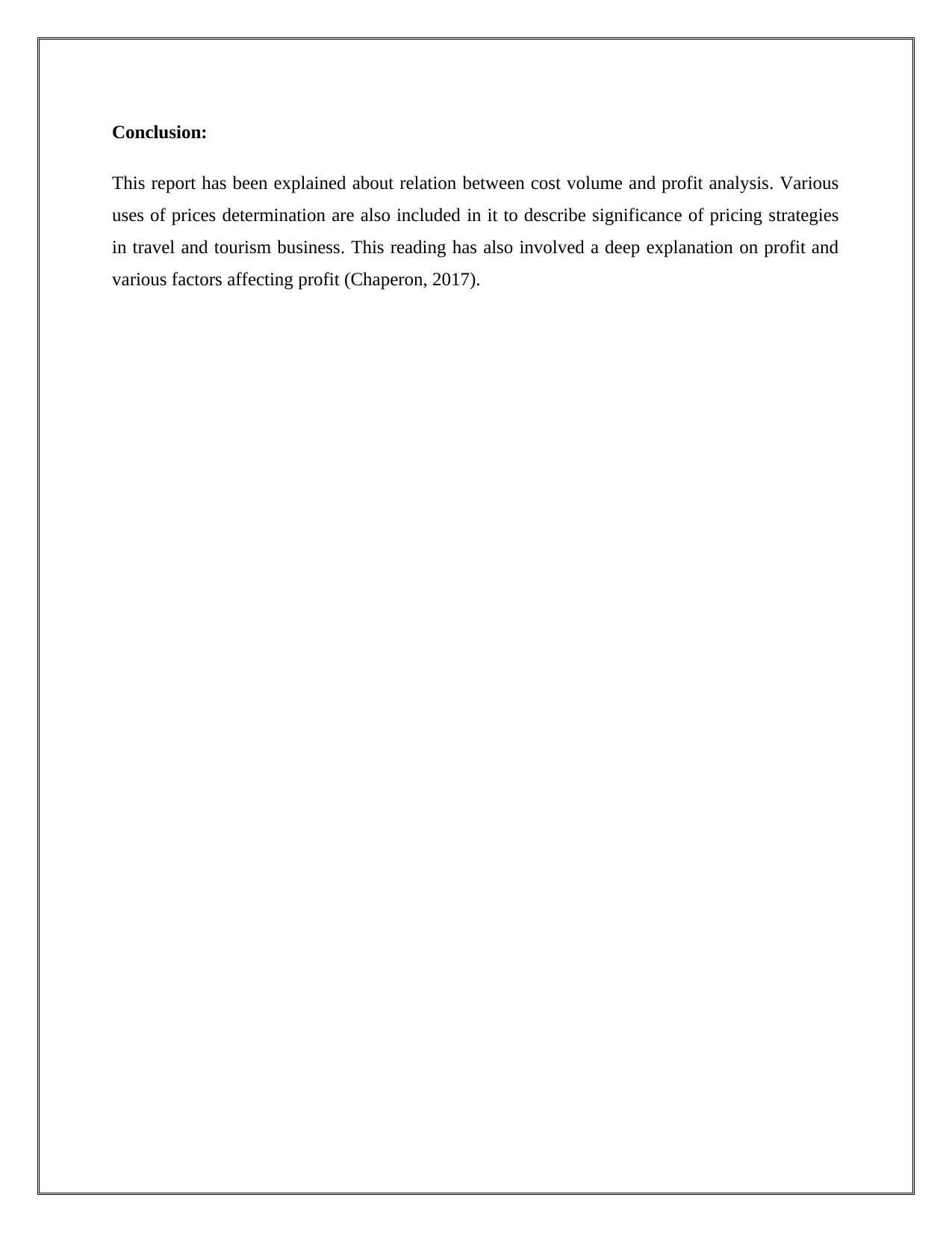
Conclusion:
This report has been explained about relation between cost volume and profit analysis. Various
uses of prices determination are also included in it to describe significance of pricing strategies
in travel and tourism business. This reading has also involved a deep explanation on profit and
various factors affecting profit (Chaperon, 2017).
This report has been explained about relation between cost volume and profit analysis. Various
uses of prices determination are also included in it to describe significance of pricing strategies
in travel and tourism business. This reading has also involved a deep explanation on profit and
various factors affecting profit (Chaperon, 2017).
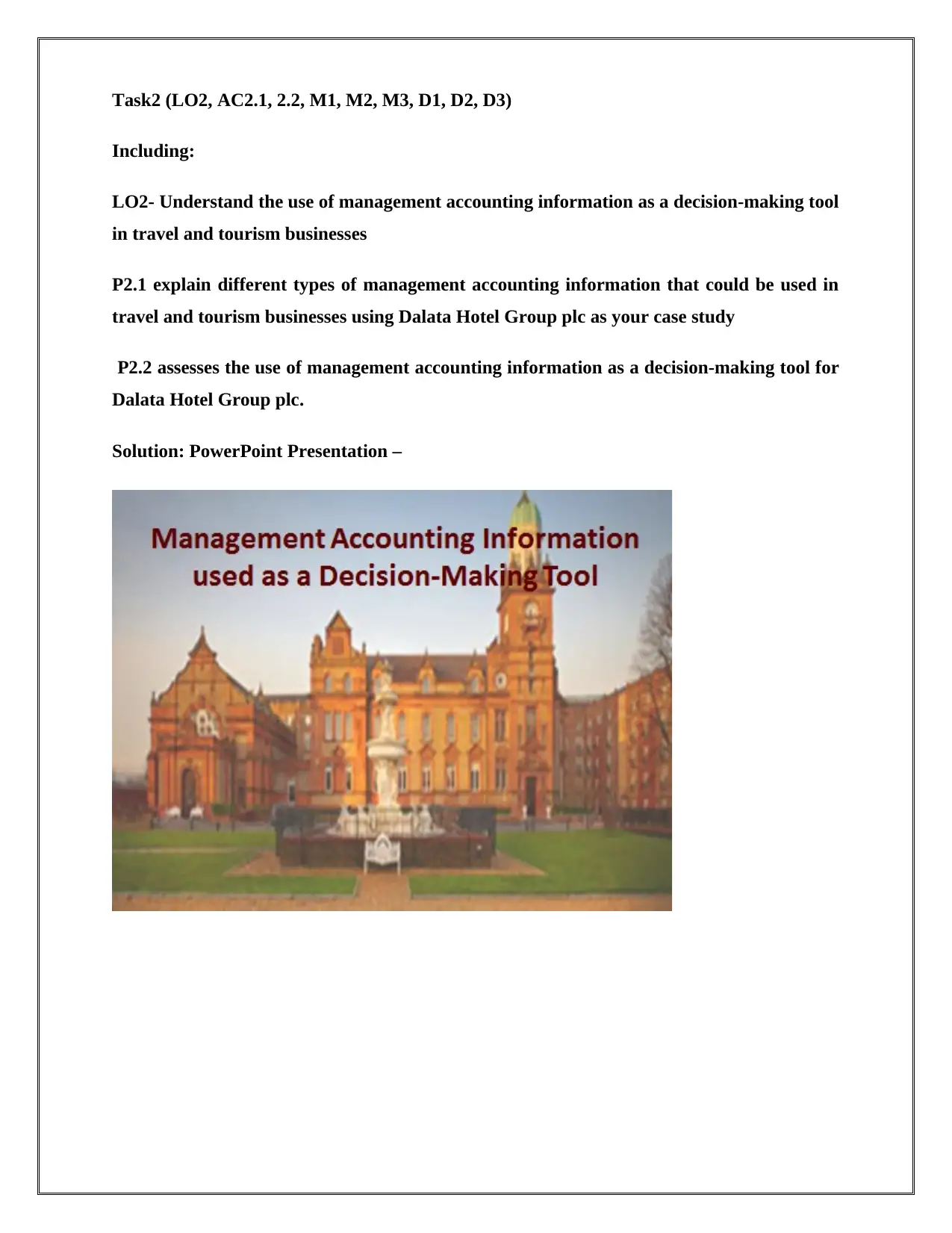
Task2 (LO2, AC2.1, 2.2, M1, M2, M3, D1, D2, D3)
Including:
LO2- Understand the use of management accounting information as a decision-making tool
in travel and tourism businesses
P2.1 explain different types of management accounting information that could be used in
travel and tourism businesses using Dalata Hotel Group plc as your case study
P2.2 assesses the use of management accounting information as a decision-making tool for
Dalata Hotel Group plc.
Solution: PowerPoint Presentation –
Including:
LO2- Understand the use of management accounting information as a decision-making tool
in travel and tourism businesses
P2.1 explain different types of management accounting information that could be used in
travel and tourism businesses using Dalata Hotel Group plc as your case study
P2.2 assesses the use of management accounting information as a decision-making tool for
Dalata Hotel Group plc.
Solution: PowerPoint Presentation –
Paraphrase This Document
Need a fresh take? Get an instant paraphrase of this document with our AI Paraphraser
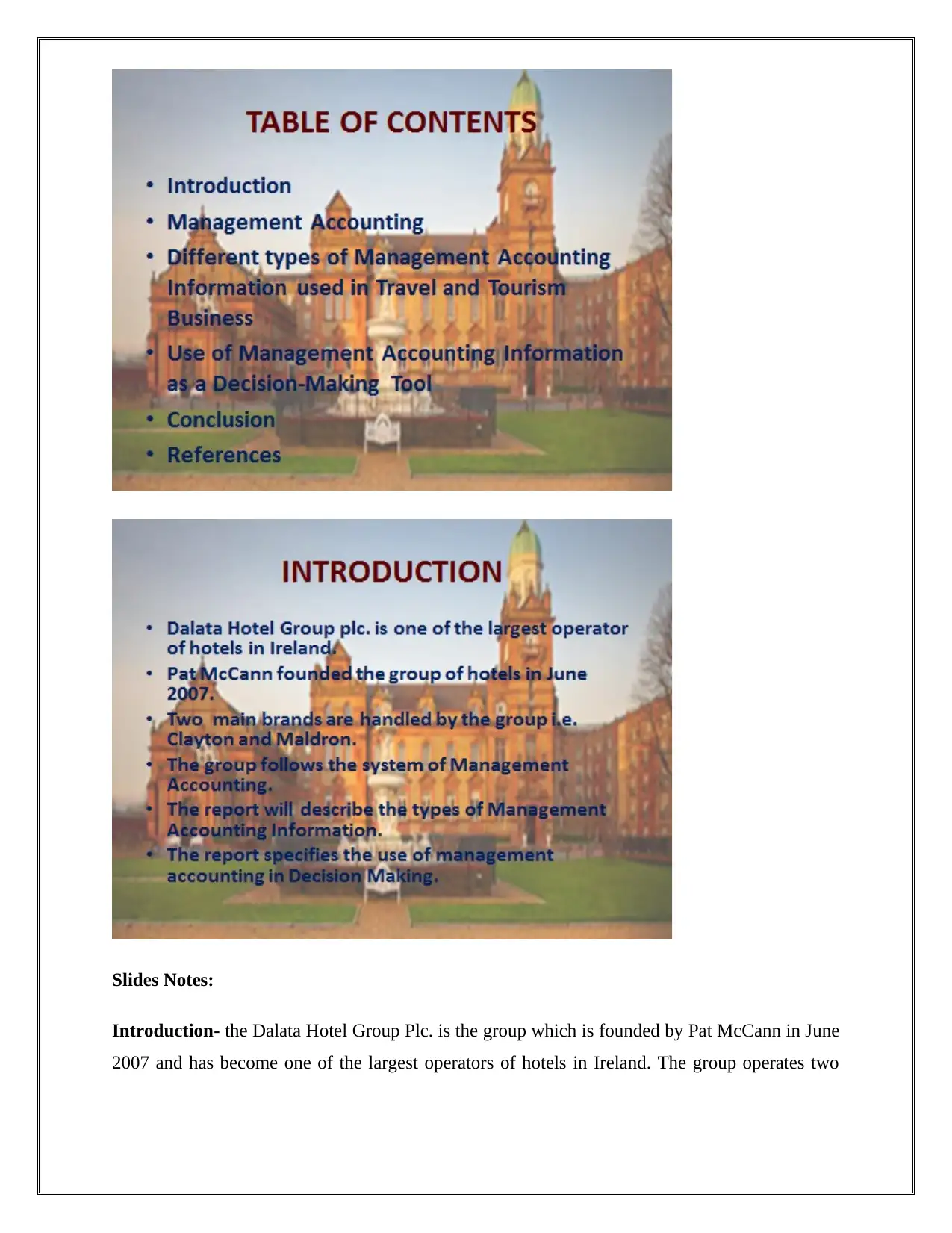
Slides Notes:
Introduction- the Dalata Hotel Group Plc. is the group which is founded by Pat McCann in June
2007 and has become one of the largest operators of hotels in Ireland. The group operates two
Introduction- the Dalata Hotel Group Plc. is the group which is founded by Pat McCann in June
2007 and has become one of the largest operators of hotels in Ireland. The group operates two
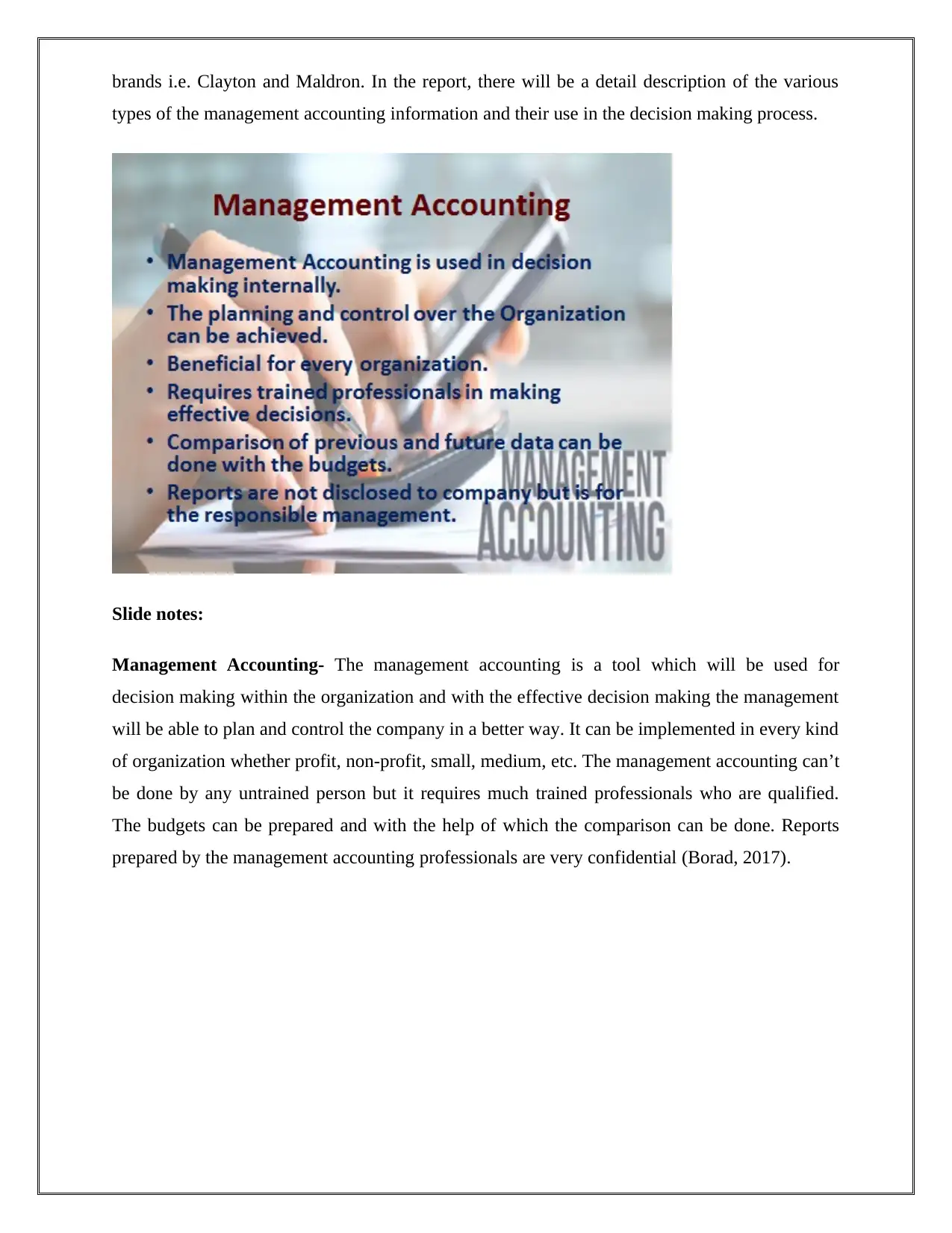
brands i.e. Clayton and Maldron. In the report, there will be a detail description of the various
types of the management accounting information and their use in the decision making process.
Slide notes:
Management Accounting- The management accounting is a tool which will be used for
decision making within the organization and with the effective decision making the management
will be able to plan and control the company in a better way. It can be implemented in every kind
of organization whether profit, non-profit, small, medium, etc. The management accounting can’t
be done by any untrained person but it requires much trained professionals who are qualified.
The budgets can be prepared and with the help of which the comparison can be done. Reports
prepared by the management accounting professionals are very confidential (Borad, 2017).
types of the management accounting information and their use in the decision making process.
Slide notes:
Management Accounting- The management accounting is a tool which will be used for
decision making within the organization and with the effective decision making the management
will be able to plan and control the company in a better way. It can be implemented in every kind
of organization whether profit, non-profit, small, medium, etc. The management accounting can’t
be done by any untrained person but it requires much trained professionals who are qualified.
The budgets can be prepared and with the help of which the comparison can be done. Reports
prepared by the management accounting professionals are very confidential (Borad, 2017).
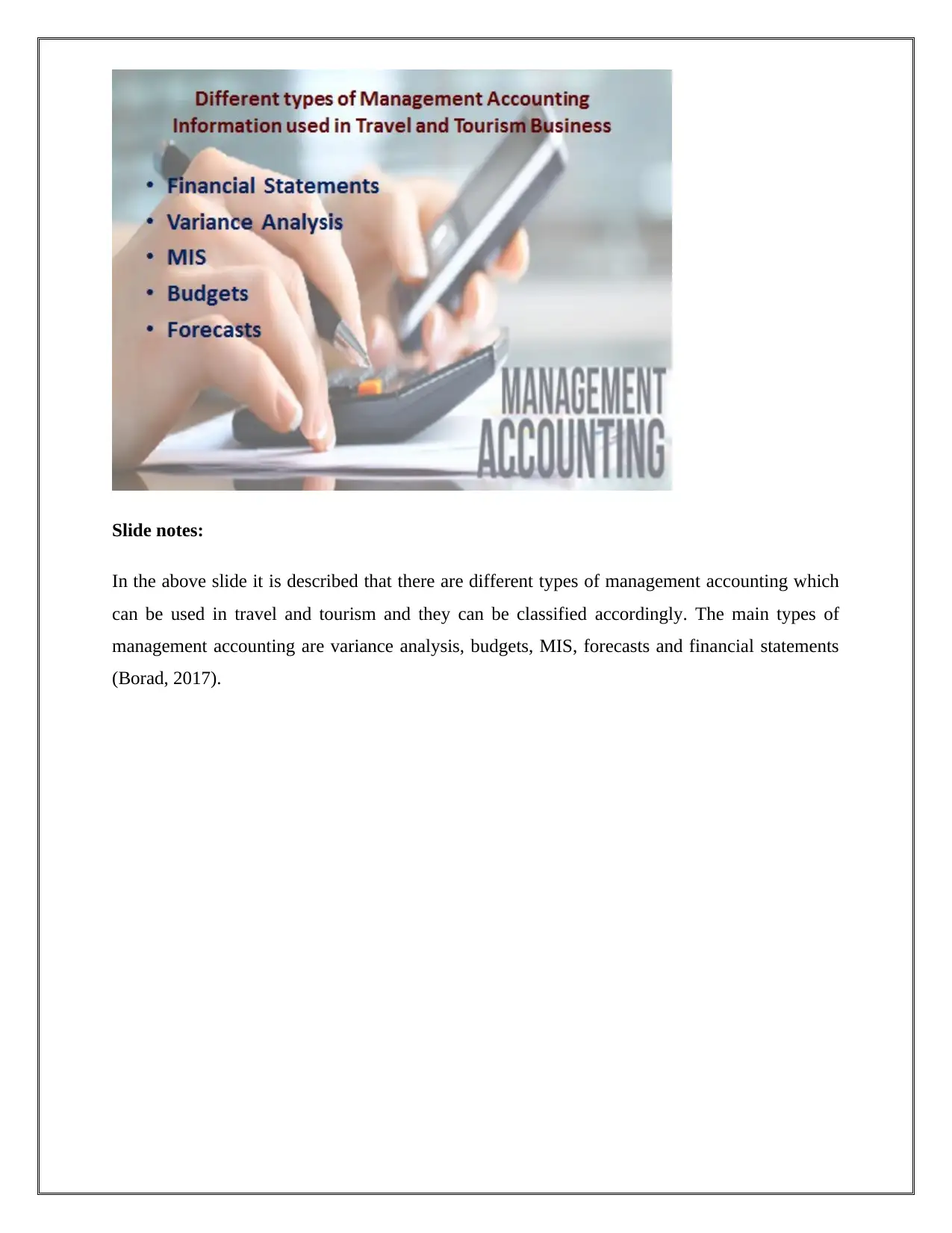
Slide notes:
In the above slide it is described that there are different types of management accounting which
can be used in travel and tourism and they can be classified accordingly. The main types of
management accounting are variance analysis, budgets, MIS, forecasts and financial statements
(Borad, 2017).
In the above slide it is described that there are different types of management accounting which
can be used in travel and tourism and they can be classified accordingly. The main types of
management accounting are variance analysis, budgets, MIS, forecasts and financial statements
(Borad, 2017).
Secure Best Marks with AI Grader
Need help grading? Try our AI Grader for instant feedback on your assignments.
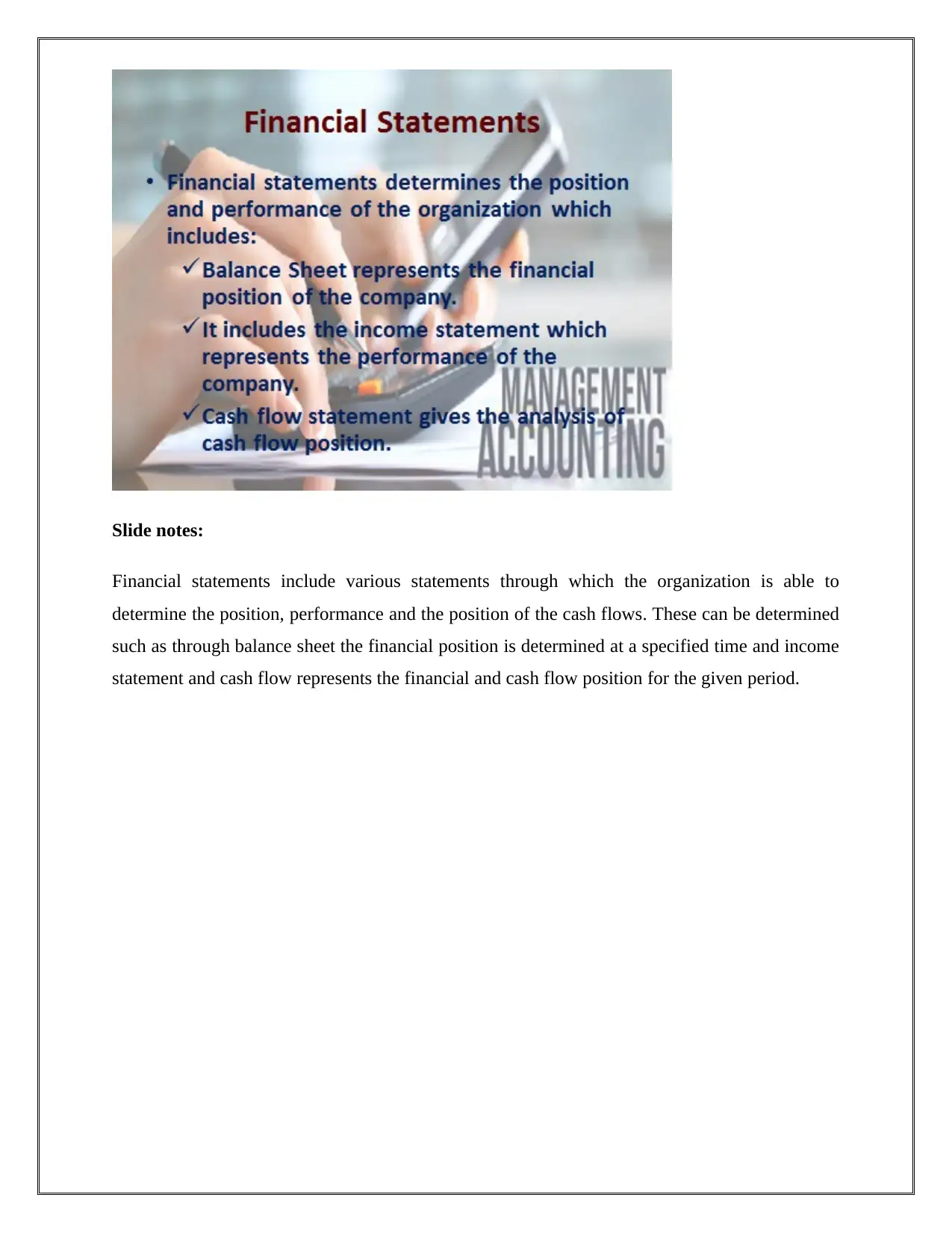
Slide notes:
Financial statements include various statements through which the organization is able to
determine the position, performance and the position of the cash flows. These can be determined
such as through balance sheet the financial position is determined at a specified time and income
statement and cash flow represents the financial and cash flow position for the given period.
Financial statements include various statements through which the organization is able to
determine the position, performance and the position of the cash flows. These can be determined
such as through balance sheet the financial position is determined at a specified time and income
statement and cash flow represents the financial and cash flow position for the given period.
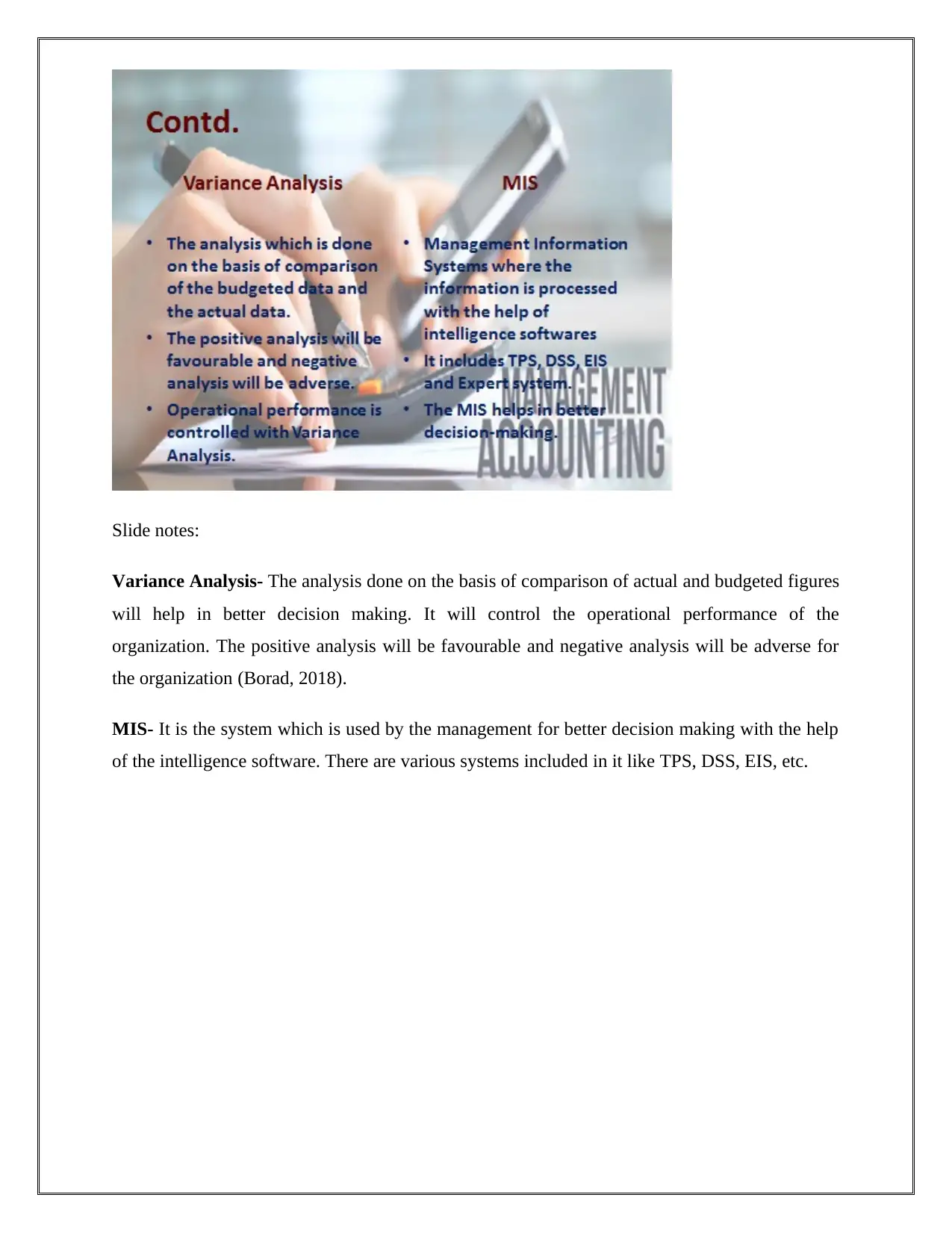
Slide notes:
Variance Analysis- The analysis done on the basis of comparison of actual and budgeted figures
will help in better decision making. It will control the operational performance of the
organization. The positive analysis will be favourable and negative analysis will be adverse for
the organization (Borad, 2018).
MIS- It is the system which is used by the management for better decision making with the help
of the intelligence software. There are various systems included in it like TPS, DSS, EIS, etc.
Variance Analysis- The analysis done on the basis of comparison of actual and budgeted figures
will help in better decision making. It will control the operational performance of the
organization. The positive analysis will be favourable and negative analysis will be adverse for
the organization (Borad, 2018).
MIS- It is the system which is used by the management for better decision making with the help
of the intelligence software. There are various systems included in it like TPS, DSS, EIS, etc.
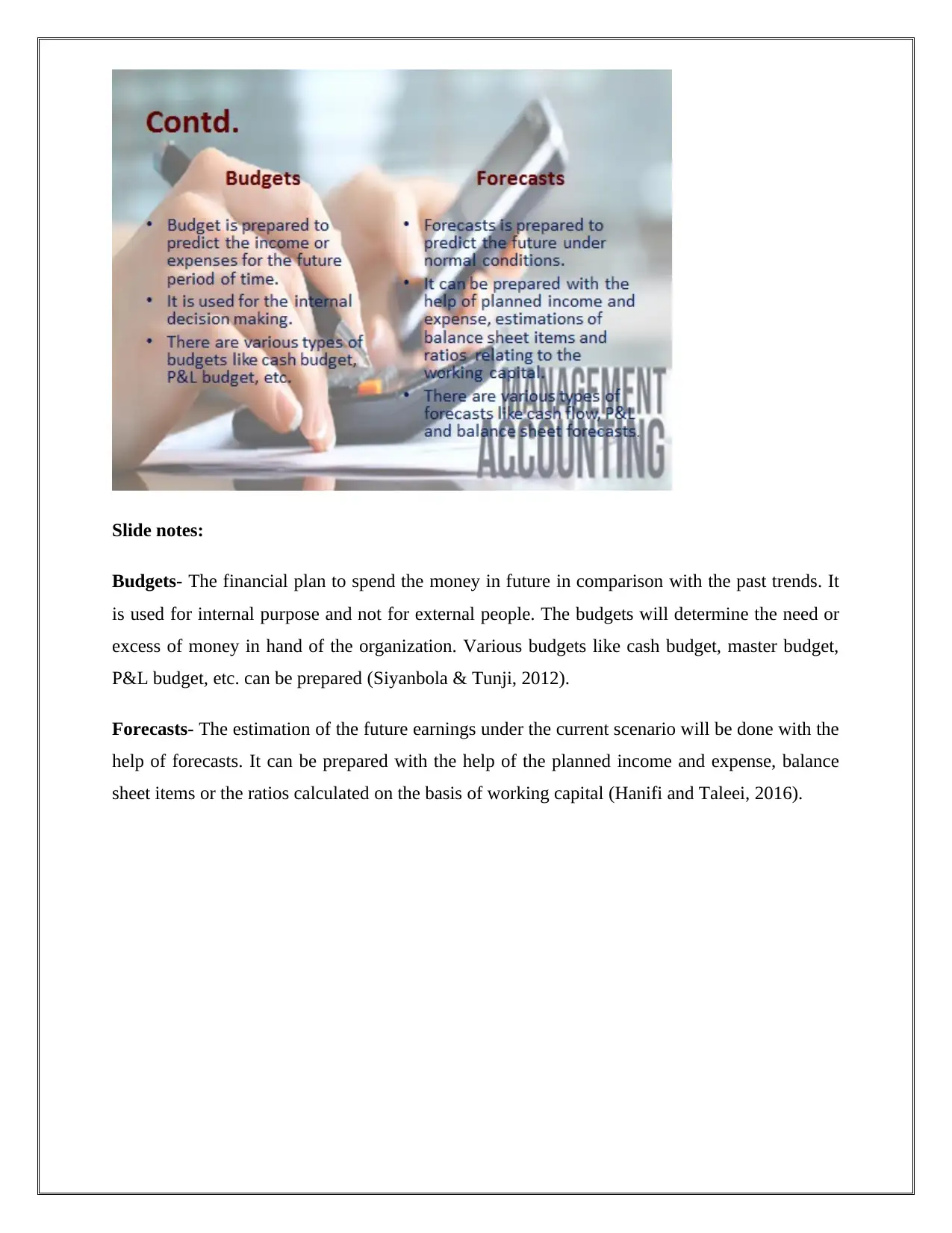
Slide notes:
Budgets- The financial plan to spend the money in future in comparison with the past trends. It
is used for internal purpose and not for external people. The budgets will determine the need or
excess of money in hand of the organization. Various budgets like cash budget, master budget,
P&L budget, etc. can be prepared (Siyanbola & Tunji, 2012).
Forecasts- The estimation of the future earnings under the current scenario will be done with the
help of forecasts. It can be prepared with the help of the planned income and expense, balance
sheet items or the ratios calculated on the basis of working capital (Hanifi and Taleei, 2016).
Budgets- The financial plan to spend the money in future in comparison with the past trends. It
is used for internal purpose and not for external people. The budgets will determine the need or
excess of money in hand of the organization. Various budgets like cash budget, master budget,
P&L budget, etc. can be prepared (Siyanbola & Tunji, 2012).
Forecasts- The estimation of the future earnings under the current scenario will be done with the
help of forecasts. It can be prepared with the help of the planned income and expense, balance
sheet items or the ratios calculated on the basis of working capital (Hanifi and Taleei, 2016).
Paraphrase This Document
Need a fresh take? Get an instant paraphrase of this document with our AI Paraphraser

The decision making is very important for the business to run successfully in the environment.
The effective decisions if taken correctly then in that case the opportunities can be identified and
if taken wrong decisions then the business will be at a loss. The future position to be estimated
requires an effective decision. The decision should be taken by considering all the pros and cons
and all the alternatives (Dalata, 2015).
The effective decisions if taken correctly then in that case the opportunities can be identified and
if taken wrong decisions then the business will be at a loss. The future position to be estimated
requires an effective decision. The decision should be taken by considering all the pros and cons
and all the alternatives (Dalata, 2015).
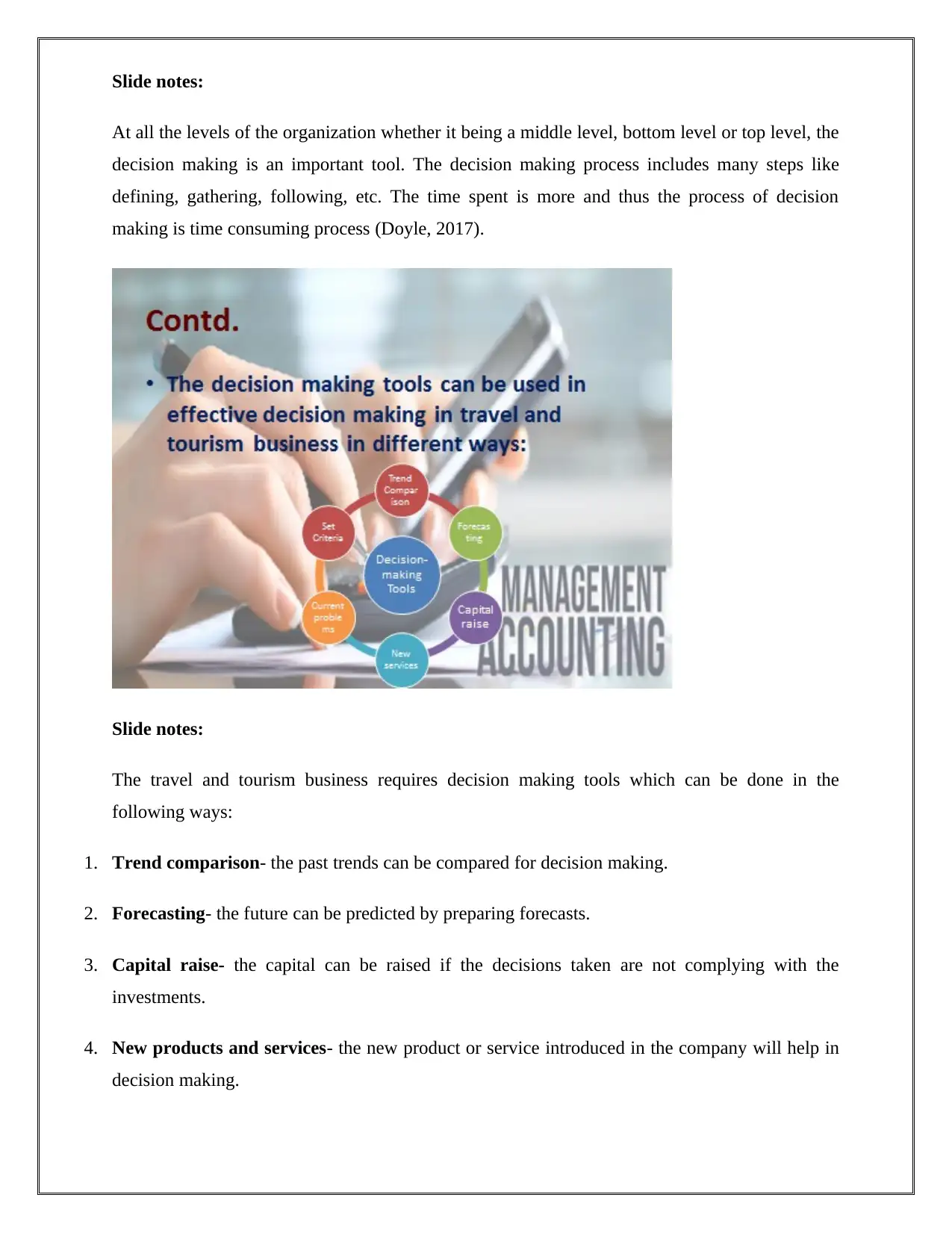
Slide notes:
At all the levels of the organization whether it being a middle level, bottom level or top level, the
decision making is an important tool. The decision making process includes many steps like
defining, gathering, following, etc. The time spent is more and thus the process of decision
making is time consuming process (Doyle, 2017).
Slide notes:
The travel and tourism business requires decision making tools which can be done in the
following ways:
1. Trend comparison- the past trends can be compared for decision making.
2. Forecasting- the future can be predicted by preparing forecasts.
3. Capital raise- the capital can be raised if the decisions taken are not complying with the
investments.
4. New products and services- the new product or service introduced in the company will help in
decision making.
At all the levels of the organization whether it being a middle level, bottom level or top level, the
decision making is an important tool. The decision making process includes many steps like
defining, gathering, following, etc. The time spent is more and thus the process of decision
making is time consuming process (Doyle, 2017).
Slide notes:
The travel and tourism business requires decision making tools which can be done in the
following ways:
1. Trend comparison- the past trends can be compared for decision making.
2. Forecasting- the future can be predicted by preparing forecasts.
3. Capital raise- the capital can be raised if the decisions taken are not complying with the
investments.
4. New products and services- the new product or service introduced in the company will help in
decision making.
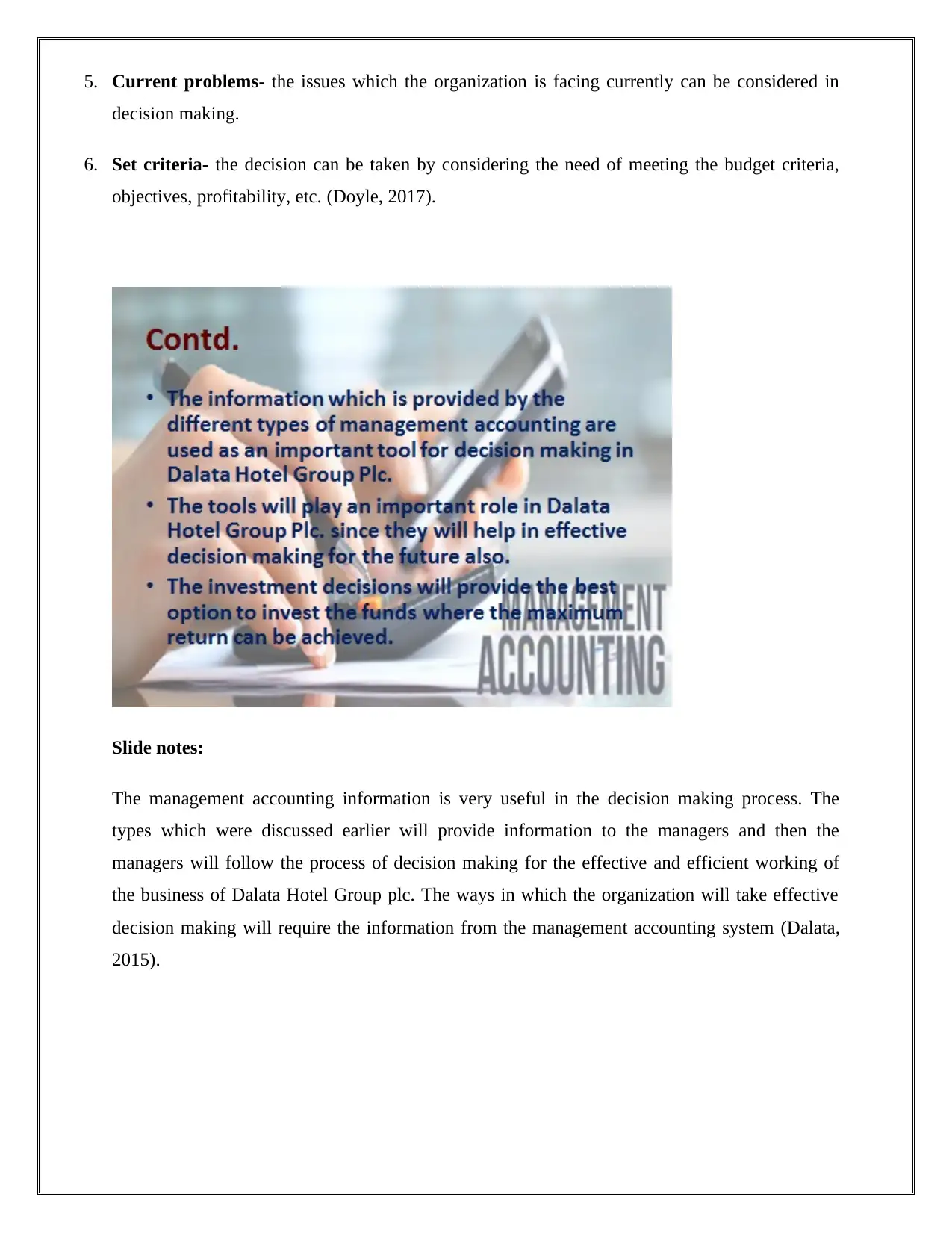
5. Current problems- the issues which the organization is facing currently can be considered in
decision making.
6. Set criteria- the decision can be taken by considering the need of meeting the budget criteria,
objectives, profitability, etc. (Doyle, 2017).
Slide notes:
The management accounting information is very useful in the decision making process. The
types which were discussed earlier will provide information to the managers and then the
managers will follow the process of decision making for the effective and efficient working of
the business of Dalata Hotel Group plc. The ways in which the organization will take effective
decision making will require the information from the management accounting system (Dalata,
2015).
decision making.
6. Set criteria- the decision can be taken by considering the need of meeting the budget criteria,
objectives, profitability, etc. (Doyle, 2017).
Slide notes:
The management accounting information is very useful in the decision making process. The
types which were discussed earlier will provide information to the managers and then the
managers will follow the process of decision making for the effective and efficient working of
the business of Dalata Hotel Group plc. The ways in which the organization will take effective
decision making will require the information from the management accounting system (Dalata,
2015).
Secure Best Marks with AI Grader
Need help grading? Try our AI Grader for instant feedback on your assignments.
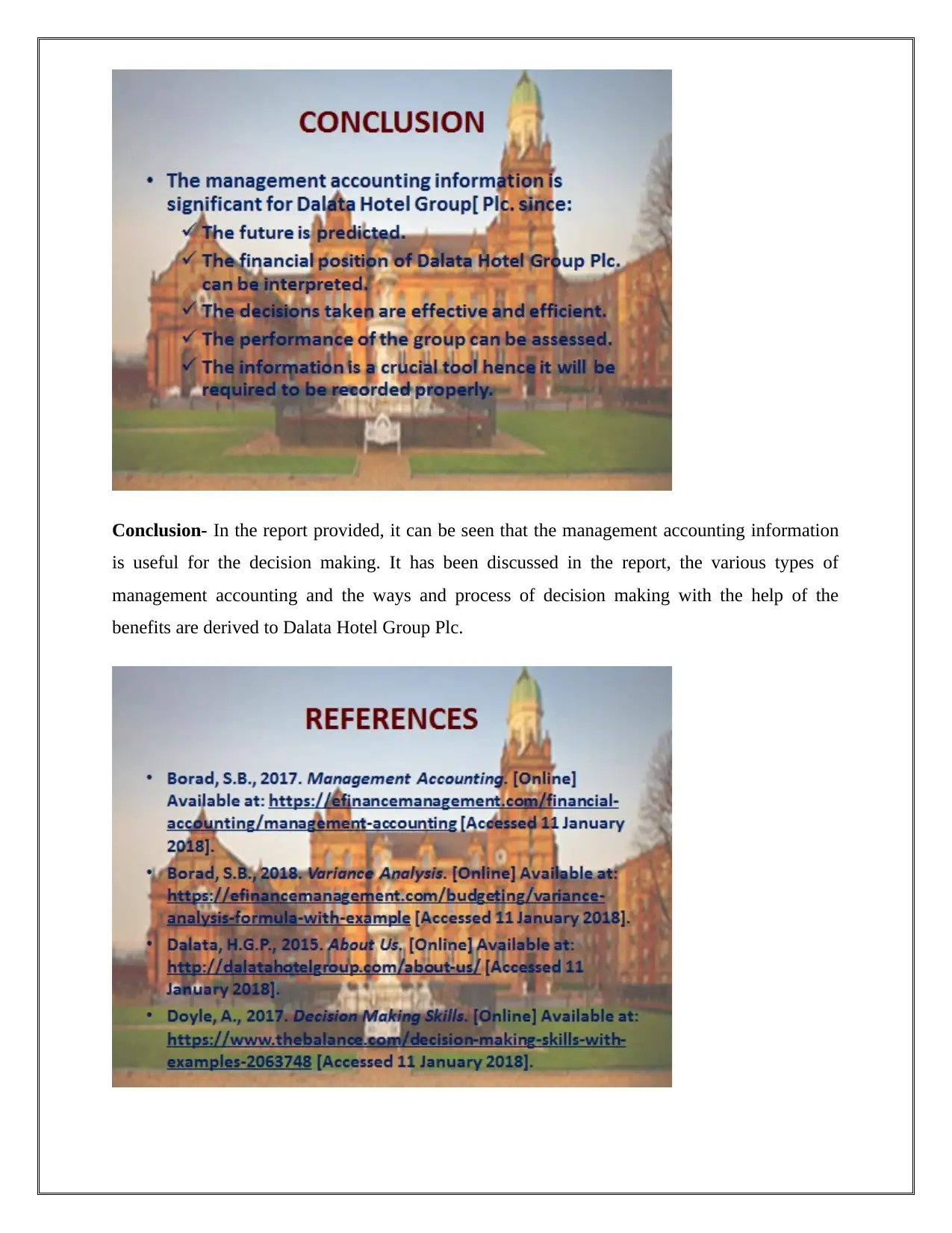
Conclusion- In the report provided, it can be seen that the management accounting information
is useful for the decision making. It has been discussed in the report, the various types of
management accounting and the ways and process of decision making with the help of the
benefits are derived to Dalata Hotel Group Plc.
is useful for the decision making. It has been discussed in the report, the various types of
management accounting and the ways and process of decision making with the help of the
benefits are derived to Dalata Hotel Group Plc.
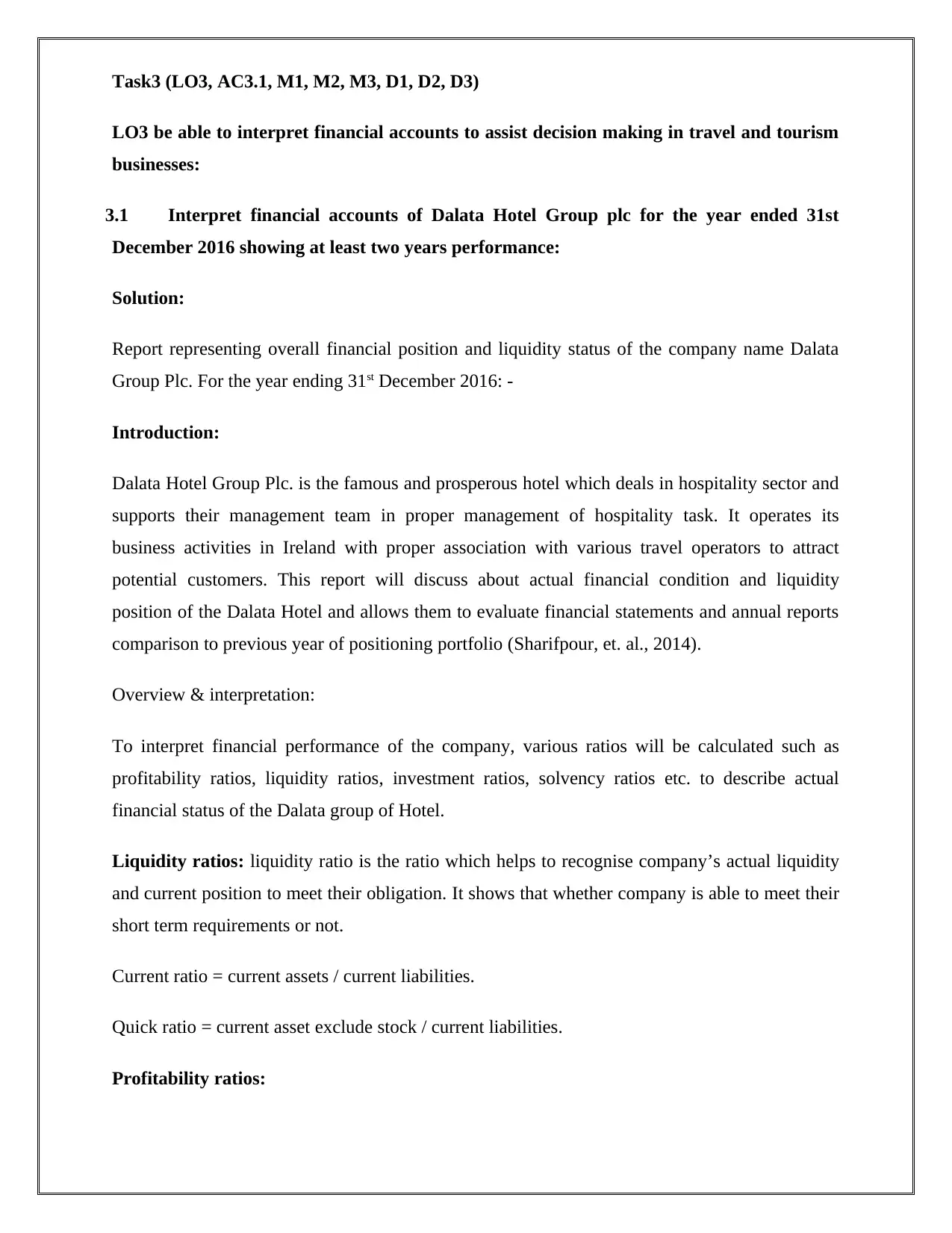
Task3 (LO3, AC3.1, M1, M2, M3, D1, D2, D3)
LO3 be able to interpret financial accounts to assist decision making in travel and tourism
businesses:
3.1 Interpret financial accounts of Dalata Hotel Group plc for the year ended 31st
December 2016 showing at least two years performance:
Solution:
Report representing overall financial position and liquidity status of the company name Dalata
Group Plc. For the year ending 31st December 2016: -
Introduction:
Dalata Hotel Group Plc. is the famous and prosperous hotel which deals in hospitality sector and
supports their management team in proper management of hospitality task. It operates its
business activities in Ireland with proper association with various travel operators to attract
potential customers. This report will discuss about actual financial condition and liquidity
position of the Dalata Hotel and allows them to evaluate financial statements and annual reports
comparison to previous year of positioning portfolio (Sharifpour, et. al., 2014).
Overview & interpretation:
To interpret financial performance of the company, various ratios will be calculated such as
profitability ratios, liquidity ratios, investment ratios, solvency ratios etc. to describe actual
financial status of the Dalata group of Hotel.
Liquidity ratios: liquidity ratio is the ratio which helps to recognise company’s actual liquidity
and current position to meet their obligation. It shows that whether company is able to meet their
short term requirements or not.
Current ratio = current assets / current liabilities.
Quick ratio = current asset exclude stock / current liabilities.
Profitability ratios:
LO3 be able to interpret financial accounts to assist decision making in travel and tourism
businesses:
3.1 Interpret financial accounts of Dalata Hotel Group plc for the year ended 31st
December 2016 showing at least two years performance:
Solution:
Report representing overall financial position and liquidity status of the company name Dalata
Group Plc. For the year ending 31st December 2016: -
Introduction:
Dalata Hotel Group Plc. is the famous and prosperous hotel which deals in hospitality sector and
supports their management team in proper management of hospitality task. It operates its
business activities in Ireland with proper association with various travel operators to attract
potential customers. This report will discuss about actual financial condition and liquidity
position of the Dalata Hotel and allows them to evaluate financial statements and annual reports
comparison to previous year of positioning portfolio (Sharifpour, et. al., 2014).
Overview & interpretation:
To interpret financial performance of the company, various ratios will be calculated such as
profitability ratios, liquidity ratios, investment ratios, solvency ratios etc. to describe actual
financial status of the Dalata group of Hotel.
Liquidity ratios: liquidity ratio is the ratio which helps to recognise company’s actual liquidity
and current position to meet their obligation. It shows that whether company is able to meet their
short term requirements or not.
Current ratio = current assets / current liabilities.
Quick ratio = current asset exclude stock / current liabilities.
Profitability ratios:
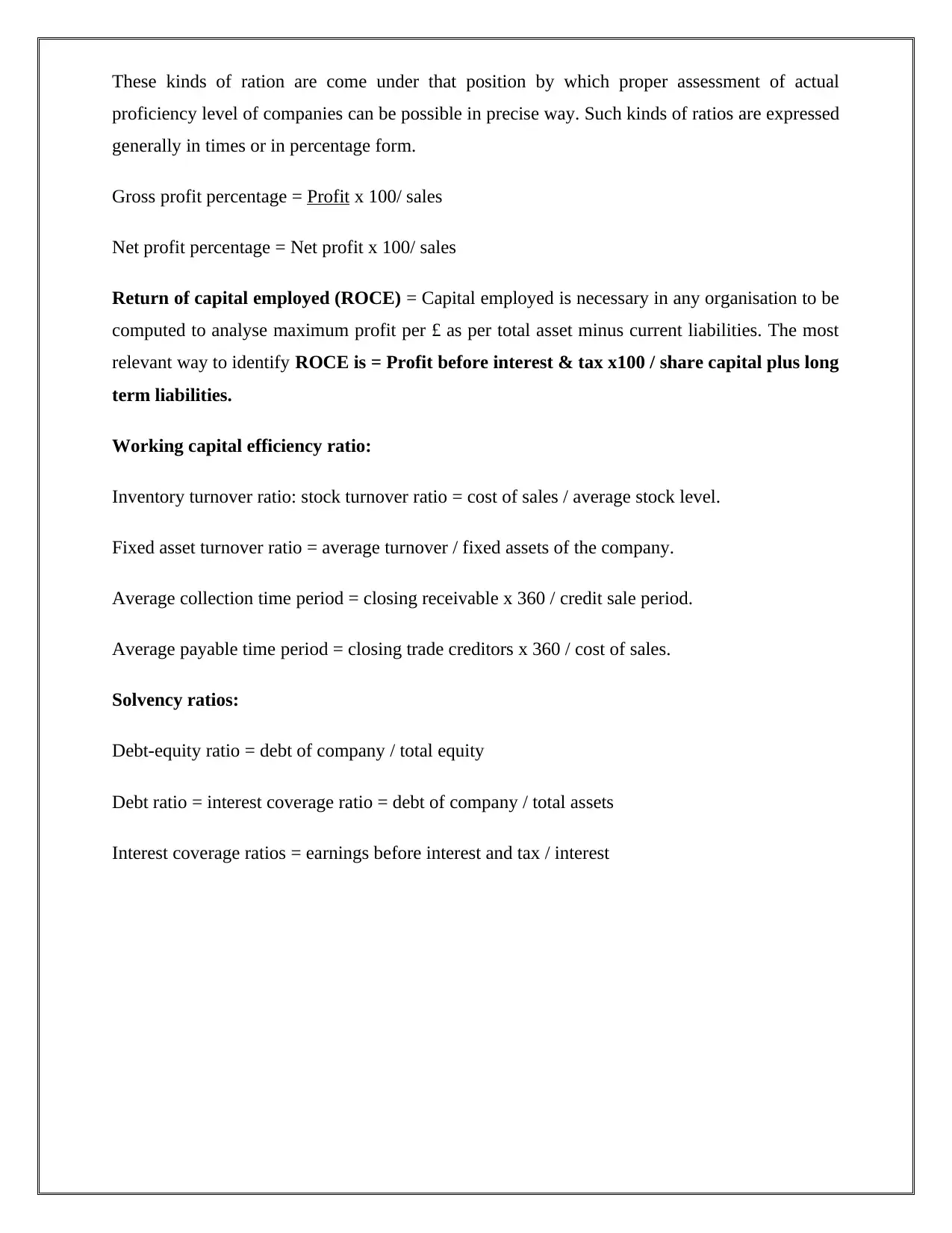
These kinds of ration are come under that position by which proper assessment of actual
proficiency level of companies can be possible in precise way. Such kinds of ratios are expressed
generally in times or in percentage form.
Gross profit percentage = Profit x 100/ sales
Net profit percentage = Net profit x 100/ sales
Return of capital employed (ROCE) = Capital employed is necessary in any organisation to be
computed to analyse maximum profit per £ as per total asset minus current liabilities. The most
relevant way to identify ROCE is = Profit before interest & tax x100 / share capital plus long
term liabilities.
Working capital efficiency ratio:
Inventory turnover ratio: stock turnover ratio = cost of sales / average stock level.
Fixed asset turnover ratio = average turnover / fixed assets of the company.
Average collection time period = closing receivable x 360 / credit sale period.
Average payable time period = closing trade creditors x 360 / cost of sales.
Solvency ratios:
Debt-equity ratio = debt of company / total equity
Debt ratio = interest coverage ratio = debt of company / total assets
Interest coverage ratios = earnings before interest and tax / interest
proficiency level of companies can be possible in precise way. Such kinds of ratios are expressed
generally in times or in percentage form.
Gross profit percentage = Profit x 100/ sales
Net profit percentage = Net profit x 100/ sales
Return of capital employed (ROCE) = Capital employed is necessary in any organisation to be
computed to analyse maximum profit per £ as per total asset minus current liabilities. The most
relevant way to identify ROCE is = Profit before interest & tax x100 / share capital plus long
term liabilities.
Working capital efficiency ratio:
Inventory turnover ratio: stock turnover ratio = cost of sales / average stock level.
Fixed asset turnover ratio = average turnover / fixed assets of the company.
Average collection time period = closing receivable x 360 / credit sale period.
Average payable time period = closing trade creditors x 360 / cost of sales.
Solvency ratios:
Debt-equity ratio = debt of company / total equity
Debt ratio = interest coverage ratio = debt of company / total assets
Interest coverage ratios = earnings before interest and tax / interest
Paraphrase This Document
Need a fresh take? Get an instant paraphrase of this document with our AI Paraphraser
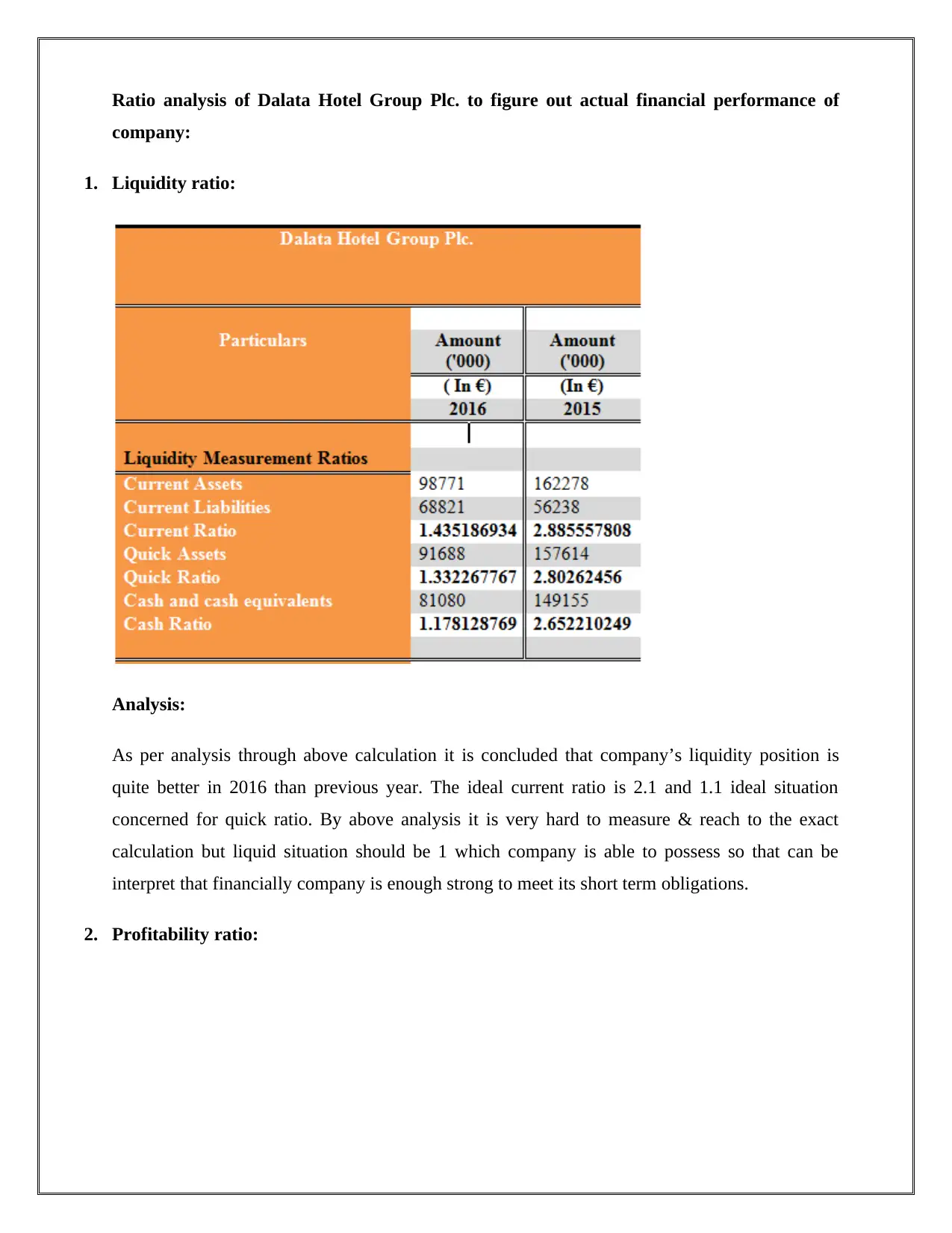
Ratio analysis of Dalata Hotel Group Plc. to figure out actual financial performance of
company:
1. Liquidity ratio:
Analysis:
As per analysis through above calculation it is concluded that company’s liquidity position is
quite better in 2016 than previous year. The ideal current ratio is 2.1 and 1.1 ideal situation
concerned for quick ratio. By above analysis it is very hard to measure & reach to the exact
calculation but liquid situation should be 1 which company is able to possess so that can be
interpret that financially company is enough strong to meet its short term obligations.
2. Profitability ratio:
company:
1. Liquidity ratio:
Analysis:
As per analysis through above calculation it is concluded that company’s liquidity position is
quite better in 2016 than previous year. The ideal current ratio is 2.1 and 1.1 ideal situation
concerned for quick ratio. By above analysis it is very hard to measure & reach to the exact
calculation but liquid situation should be 1 which company is able to possess so that can be
interpret that financially company is enough strong to meet its short term obligations.
2. Profitability ratio:
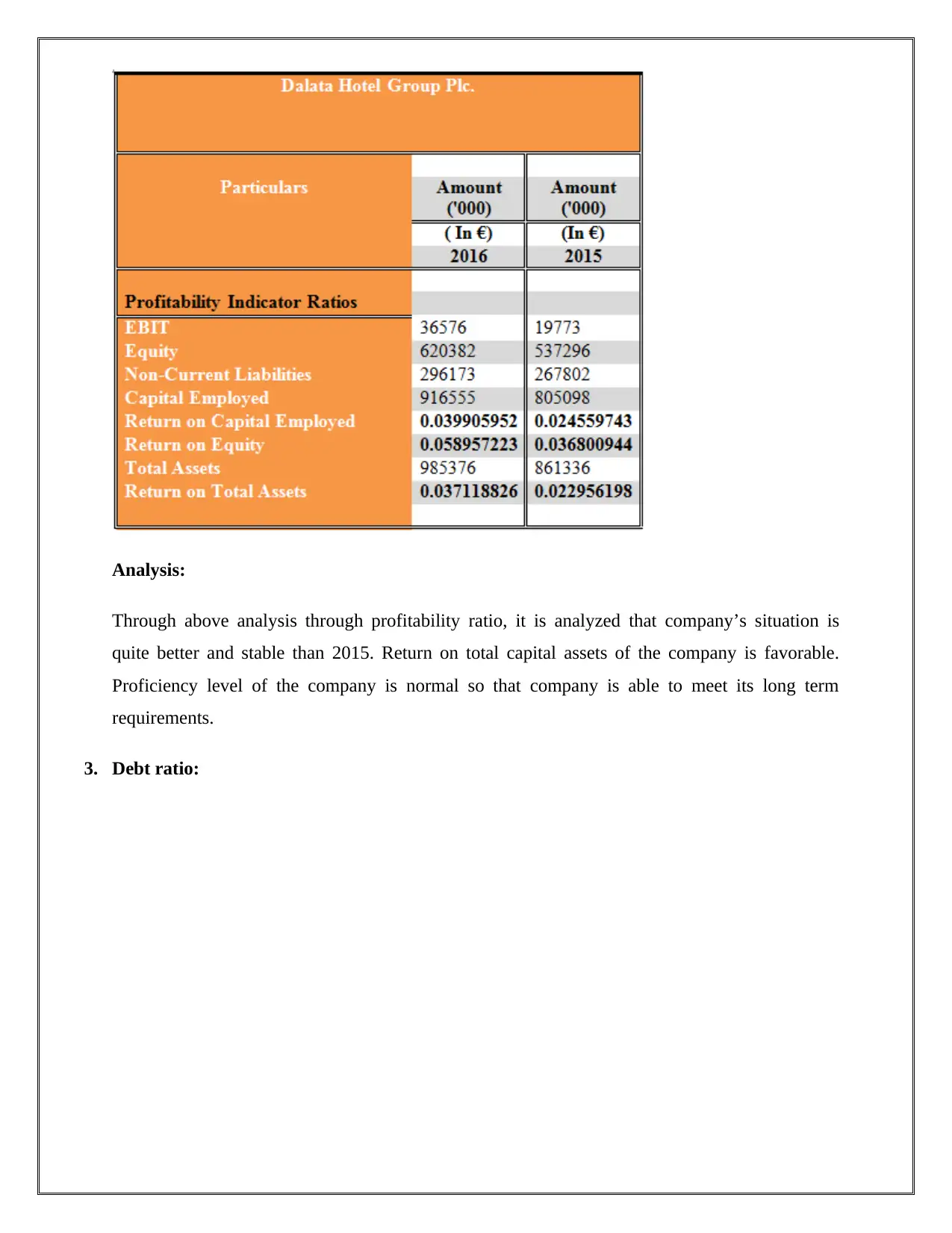
Analysis:
Through above analysis through profitability ratio, it is analyzed that company’s situation is
quite better and stable than 2015. Return on total capital assets of the company is favorable.
Proficiency level of the company is normal so that company is able to meet its long term
requirements.
3. Debt ratio:
Through above analysis through profitability ratio, it is analyzed that company’s situation is
quite better and stable than 2015. Return on total capital assets of the company is favorable.
Proficiency level of the company is normal so that company is able to meet its long term
requirements.
3. Debt ratio:

Analysis:
Debt equity ratio explains and helps the company to interpret their actual relation between debt
and equity and relation of debt with total assets through this analysis, it can be observed that
Dalata Group of Hotel are able to meet their long term obligations. Company’s financial position
is stable and preferable investors can easily invest in related projects for getting long term
returns.
4. Operating performance ratio:
Debt equity ratio explains and helps the company to interpret their actual relation between debt
and equity and relation of debt with total assets through this analysis, it can be observed that
Dalata Group of Hotel are able to meet their long term obligations. Company’s financial position
is stable and preferable investors can easily invest in related projects for getting long term
returns.
4. Operating performance ratio:
Secure Best Marks with AI Grader
Need help grading? Try our AI Grader for instant feedback on your assignments.
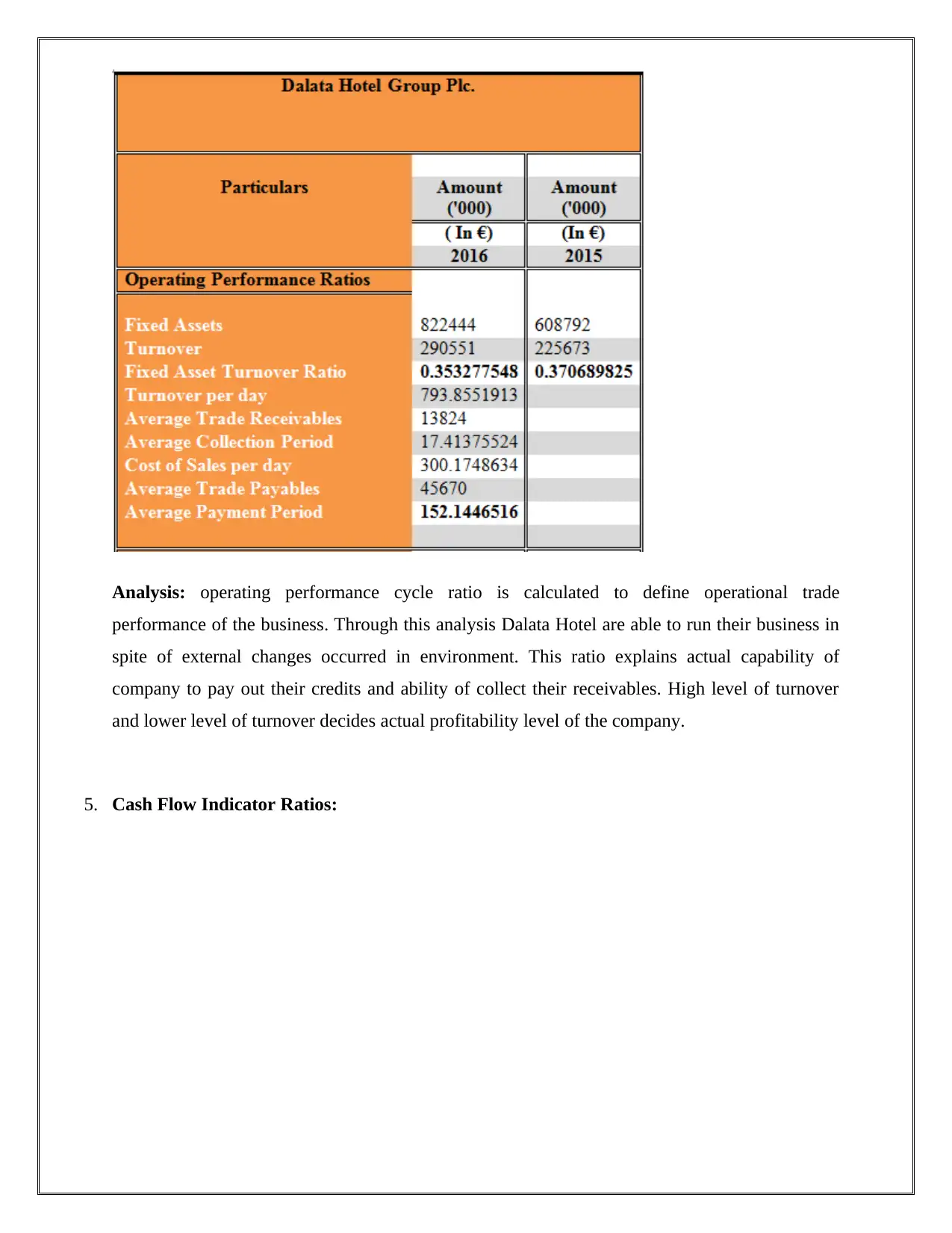
Analysis: operating performance cycle ratio is calculated to define operational trade
performance of the business. Through this analysis Dalata Hotel are able to run their business in
spite of external changes occurred in environment. This ratio explains actual capability of
company to pay out their credits and ability of collect their receivables. High level of turnover
and lower level of turnover decides actual profitability level of the company.
5. Cash Flow Indicator Ratios:
performance of the business. Through this analysis Dalata Hotel are able to run their business in
spite of external changes occurred in environment. This ratio explains actual capability of
company to pay out their credits and ability of collect their receivables. High level of turnover
and lower level of turnover decides actual profitability level of the company.
5. Cash Flow Indicator Ratios:
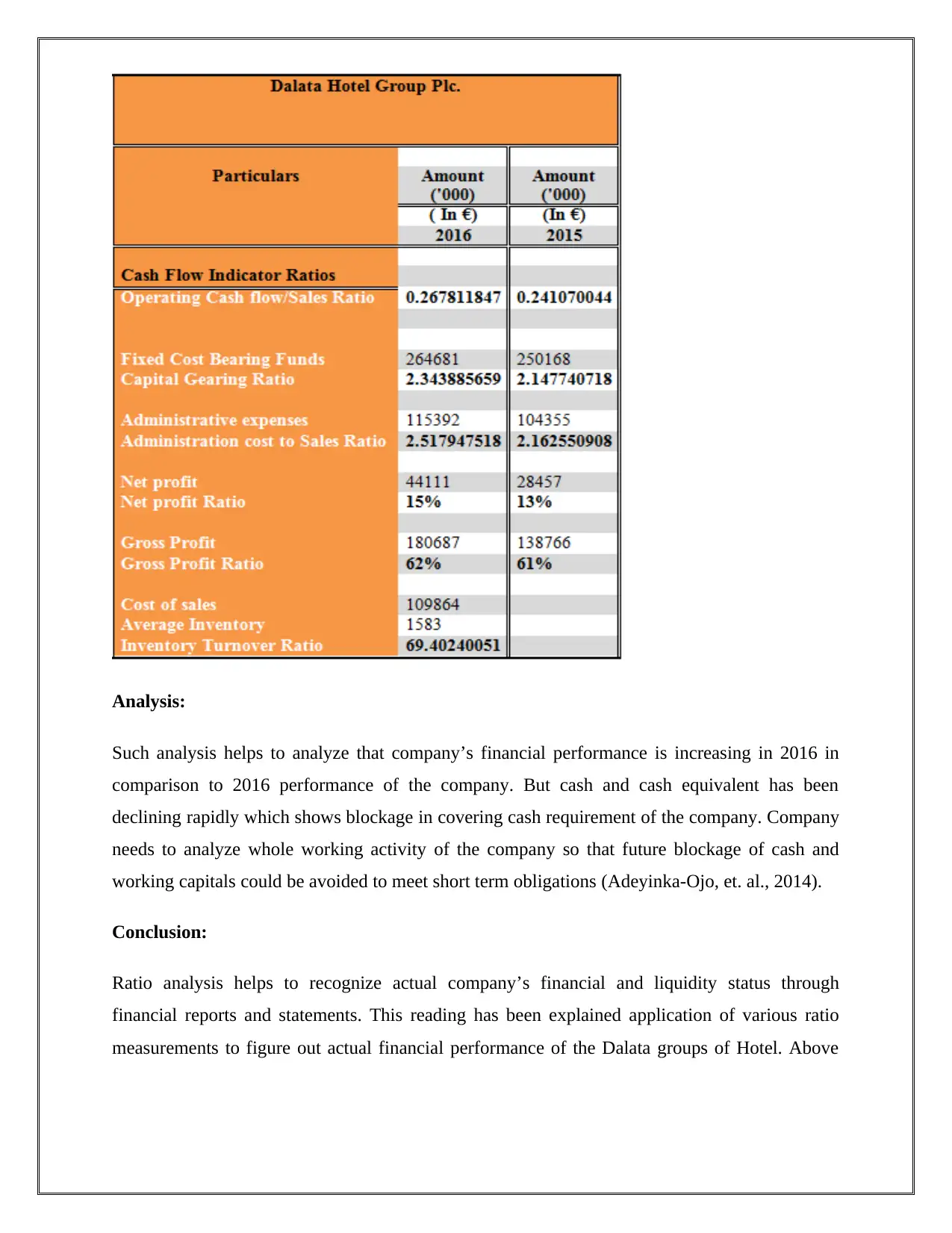
Analysis:
Such analysis helps to analyze that company’s financial performance is increasing in 2016 in
comparison to 2016 performance of the company. But cash and cash equivalent has been
declining rapidly which shows blockage in covering cash requirement of the company. Company
needs to analyze whole working activity of the company so that future blockage of cash and
working capitals could be avoided to meet short term obligations (Adeyinka-Ojo, et. al., 2014).
Conclusion:
Ratio analysis helps to recognize actual company’s financial and liquidity status through
financial reports and statements. This reading has been explained application of various ratio
measurements to figure out actual financial performance of the Dalata groups of Hotel. Above
Such analysis helps to analyze that company’s financial performance is increasing in 2016 in
comparison to 2016 performance of the company. But cash and cash equivalent has been
declining rapidly which shows blockage in covering cash requirement of the company. Company
needs to analyze whole working activity of the company so that future blockage of cash and
working capitals could be avoided to meet short term obligations (Adeyinka-Ojo, et. al., 2014).
Conclusion:
Ratio analysis helps to recognize actual company’s financial and liquidity status through
financial reports and statements. This reading has been explained application of various ratio
measurements to figure out actual financial performance of the Dalata groups of Hotel. Above
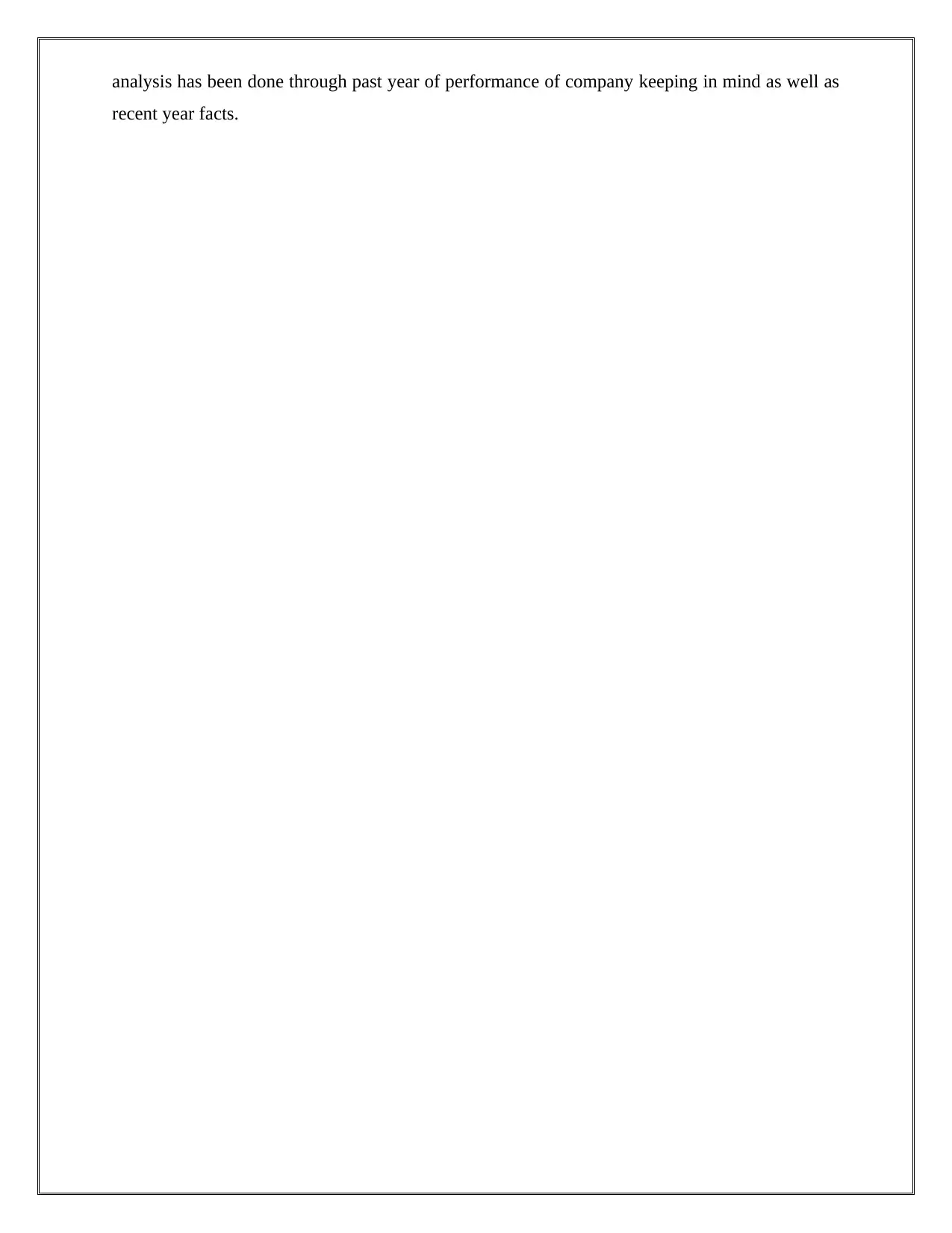
analysis has been done through past year of performance of company keeping in mind as well as
recent year facts.
recent year facts.
Paraphrase This Document
Need a fresh take? Get an instant paraphrase of this document with our AI Paraphraser
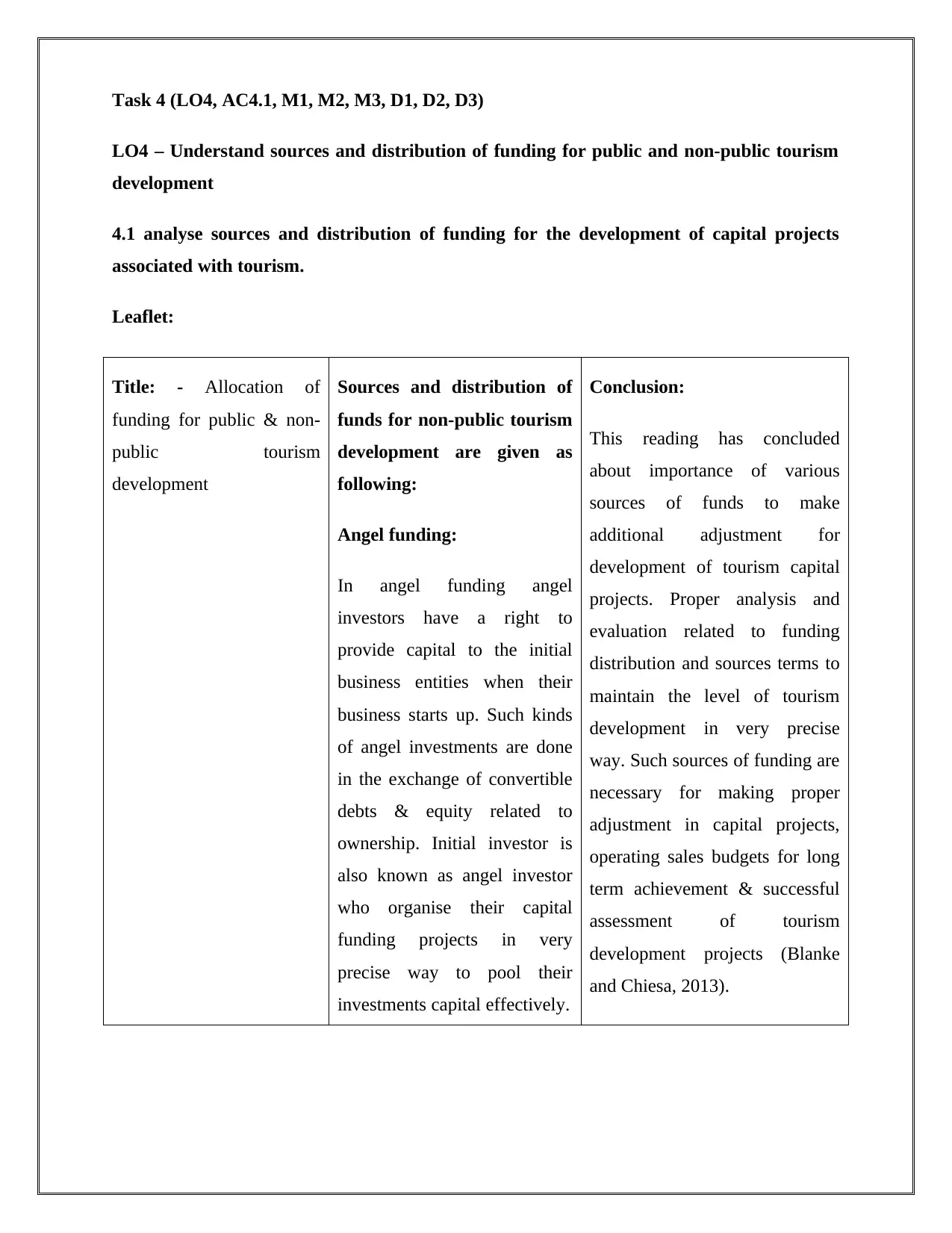
Task 4 (LO4, AC4.1, M1, M2, M3, D1, D2, D3)
LO4 – Understand sources and distribution of funding for public and non-public tourism
development
4.1 analyse sources and distribution of funding for the development of capital projects
associated with tourism.
Leaflet:
Title: - Allocation of
funding for public & non-
public tourism
development
Sources and distribution of
funds for non-public tourism
development are given as
following:
Angel funding:
In angel funding angel
investors have a right to
provide capital to the initial
business entities when their
business starts up. Such kinds
of angel investments are done
in the exchange of convertible
debts & equity related to
ownership. Initial investor is
also known as angel investor
who organise their capital
funding projects in very
precise way to pool their
investments capital effectively.
Conclusion:
This reading has concluded
about importance of various
sources of funds to make
additional adjustment for
development of tourism capital
projects. Proper analysis and
evaluation related to funding
distribution and sources terms to
maintain the level of tourism
development in very precise
way. Such sources of funding are
necessary for making proper
adjustment in capital projects,
operating sales budgets for long
term achievement & successful
assessment of tourism
development projects (Blanke
and Chiesa, 2013).
LO4 – Understand sources and distribution of funding for public and non-public tourism
development
4.1 analyse sources and distribution of funding for the development of capital projects
associated with tourism.
Leaflet:
Title: - Allocation of
funding for public & non-
public tourism
development
Sources and distribution of
funds for non-public tourism
development are given as
following:
Angel funding:
In angel funding angel
investors have a right to
provide capital to the initial
business entities when their
business starts up. Such kinds
of angel investments are done
in the exchange of convertible
debts & equity related to
ownership. Initial investor is
also known as angel investor
who organise their capital
funding projects in very
precise way to pool their
investments capital effectively.
Conclusion:
This reading has concluded
about importance of various
sources of funds to make
additional adjustment for
development of tourism capital
projects. Proper analysis and
evaluation related to funding
distribution and sources terms to
maintain the level of tourism
development in very precise
way. Such sources of funding are
necessary for making proper
adjustment in capital projects,
operating sales budgets for long
term achievement & successful
assessment of tourism
development projects (Blanke
and Chiesa, 2013).
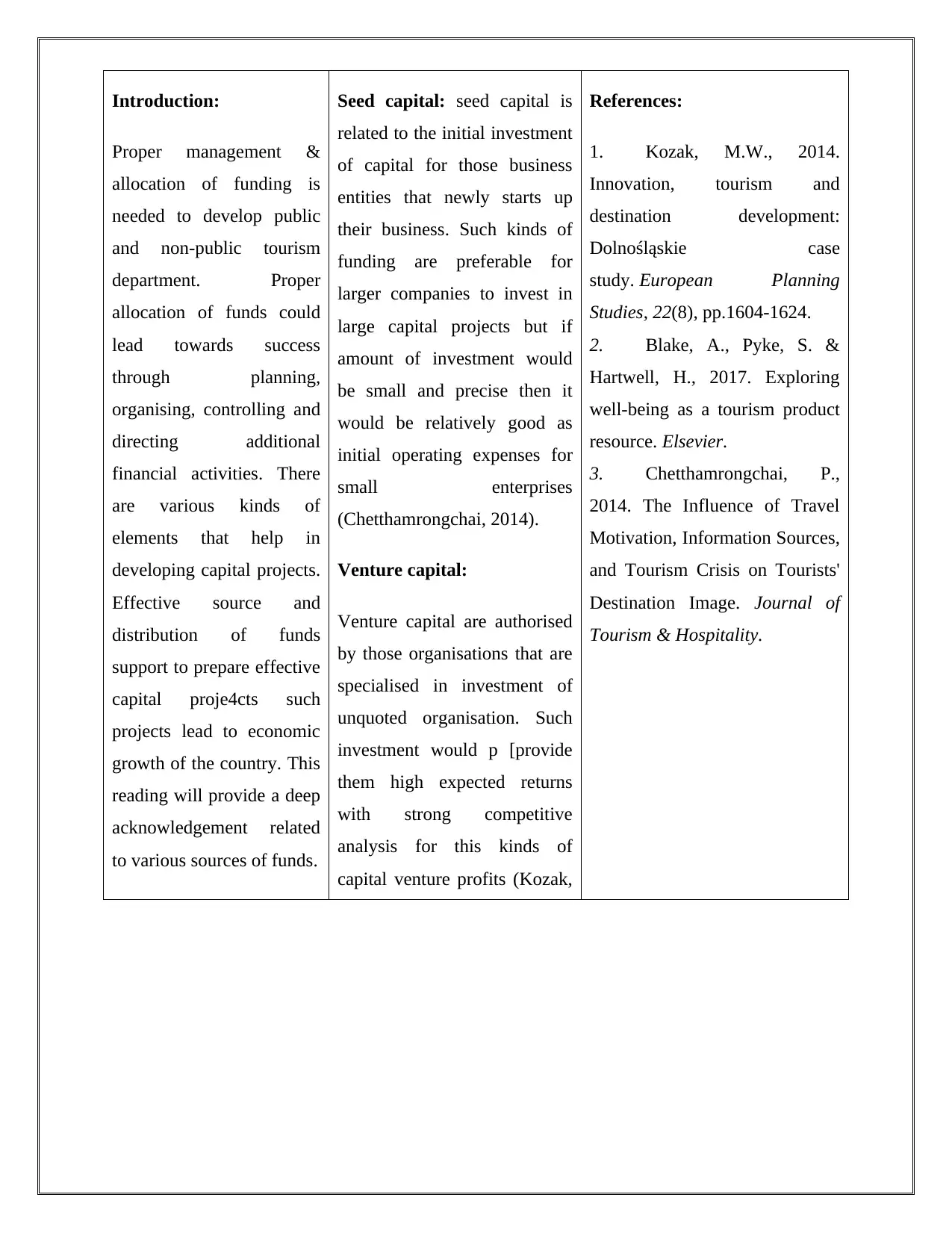
Seed capital: seed capital is
related to the initial investment
of capital for those business
entities that newly starts up
their business. Such kinds of
funding are preferable for
larger companies to invest in
large capital projects but if
amount of investment would
be small and precise then it
would be relatively good as
initial operating expenses for
small enterprises
(Chetthamrongchai, 2014).
Venture capital:
Venture capital are authorised
by those organisations that are
specialised in investment of
unquoted organisation. Such
investment would p [provide
them high expected returns
with strong competitive
analysis for this kinds of
capital venture profits (Kozak,
Introduction:
Proper management &
allocation of funding is
needed to develop public
and non-public tourism
department. Proper
allocation of funds could
lead towards success
through planning,
organising, controlling and
directing additional
financial activities. There
are various kinds of
elements that help in
developing capital projects.
Effective source and
distribution of funds
support to prepare effective
capital proje4cts such
projects lead to economic
growth of the country. This
reading will provide a deep
acknowledgement related
to various sources of funds.
References:
1. Kozak, M.W., 2014.
Innovation, tourism and
destination development:
Dolnośląskie case
study. European Planning
Studies, 22(8), pp.1604-1624.
2. Blake, A., Pyke, S. &
Hartwell, H., 2017. Exploring
well-being as a tourism product
resource. Elsevier.
3. Chetthamrongchai, P.,
2014. The Influence of Travel
Motivation, Information Sources,
and Tourism Crisis on Tourists'
Destination Image. Journal of
Tourism & Hospitality.
related to the initial investment
of capital for those business
entities that newly starts up
their business. Such kinds of
funding are preferable for
larger companies to invest in
large capital projects but if
amount of investment would
be small and precise then it
would be relatively good as
initial operating expenses for
small enterprises
(Chetthamrongchai, 2014).
Venture capital:
Venture capital are authorised
by those organisations that are
specialised in investment of
unquoted organisation. Such
investment would p [provide
them high expected returns
with strong competitive
analysis for this kinds of
capital venture profits (Kozak,
Introduction:
Proper management &
allocation of funding is
needed to develop public
and non-public tourism
department. Proper
allocation of funds could
lead towards success
through planning,
organising, controlling and
directing additional
financial activities. There
are various kinds of
elements that help in
developing capital projects.
Effective source and
distribution of funds
support to prepare effective
capital proje4cts such
projects lead to economic
growth of the country. This
reading will provide a deep
acknowledgement related
to various sources of funds.
References:
1. Kozak, M.W., 2014.
Innovation, tourism and
destination development:
Dolnośląskie case
study. European Planning
Studies, 22(8), pp.1604-1624.
2. Blake, A., Pyke, S. &
Hartwell, H., 2017. Exploring
well-being as a tourism product
resource. Elsevier.
3. Chetthamrongchai, P.,
2014. The Influence of Travel
Motivation, Information Sources,
and Tourism Crisis on Tourists'
Destination Image. Journal of
Tourism & Hospitality.
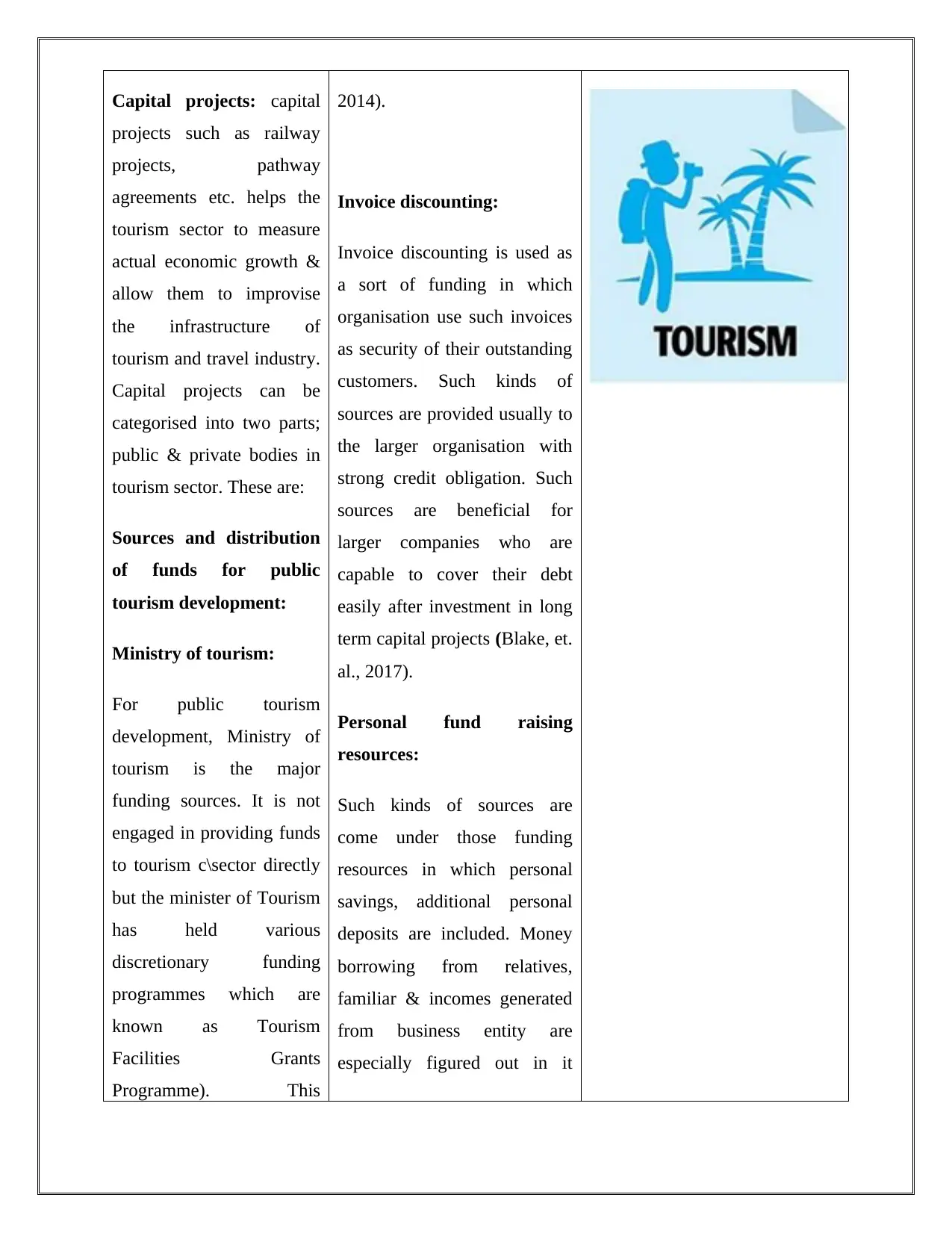
2014).
Invoice discounting:
Invoice discounting is used as
a sort of funding in which
organisation use such invoices
as security of their outstanding
customers. Such kinds of
sources are provided usually to
the larger organisation with
strong credit obligation. Such
sources are beneficial for
larger companies who are
capable to cover their debt
easily after investment in long
term capital projects (Blake, et.
al., 2017).
Personal fund raising
resources:
Such kinds of sources are
come under those funding
resources in which personal
savings, additional personal
deposits are included. Money
borrowing from relatives,
familiar & incomes generated
from business entity are
especially figured out in it
Capital projects: capital
projects such as railway
projects, pathway
agreements etc. helps the
tourism sector to measure
actual economic growth &
allow them to improvise
the infrastructure of
tourism and travel industry.
Capital projects can be
categorised into two parts;
public & private bodies in
tourism sector. These are:
Sources and distribution
of funds for public
tourism development:
Ministry of tourism:
For public tourism
development, Ministry of
tourism is the major
funding sources. It is not
engaged in providing funds
to tourism c\sector directly
but the minister of Tourism
has held various
discretionary funding
programmes which are
known as Tourism
Facilities Grants
Programme). This
Invoice discounting:
Invoice discounting is used as
a sort of funding in which
organisation use such invoices
as security of their outstanding
customers. Such kinds of
sources are provided usually to
the larger organisation with
strong credit obligation. Such
sources are beneficial for
larger companies who are
capable to cover their debt
easily after investment in long
term capital projects (Blake, et.
al., 2017).
Personal fund raising
resources:
Such kinds of sources are
come under those funding
resources in which personal
savings, additional personal
deposits are included. Money
borrowing from relatives,
familiar & incomes generated
from business entity are
especially figured out in it
Capital projects: capital
projects such as railway
projects, pathway
agreements etc. helps the
tourism sector to measure
actual economic growth &
allow them to improvise
the infrastructure of
tourism and travel industry.
Capital projects can be
categorised into two parts;
public & private bodies in
tourism sector. These are:
Sources and distribution
of funds for public
tourism development:
Ministry of tourism:
For public tourism
development, Ministry of
tourism is the major
funding sources. It is not
engaged in providing funds
to tourism c\sector directly
but the minister of Tourism
has held various
discretionary funding
programmes which are
known as Tourism
Facilities Grants
Programme). This
Secure Best Marks with AI Grader
Need help grading? Try our AI Grader for instant feedback on your assignments.
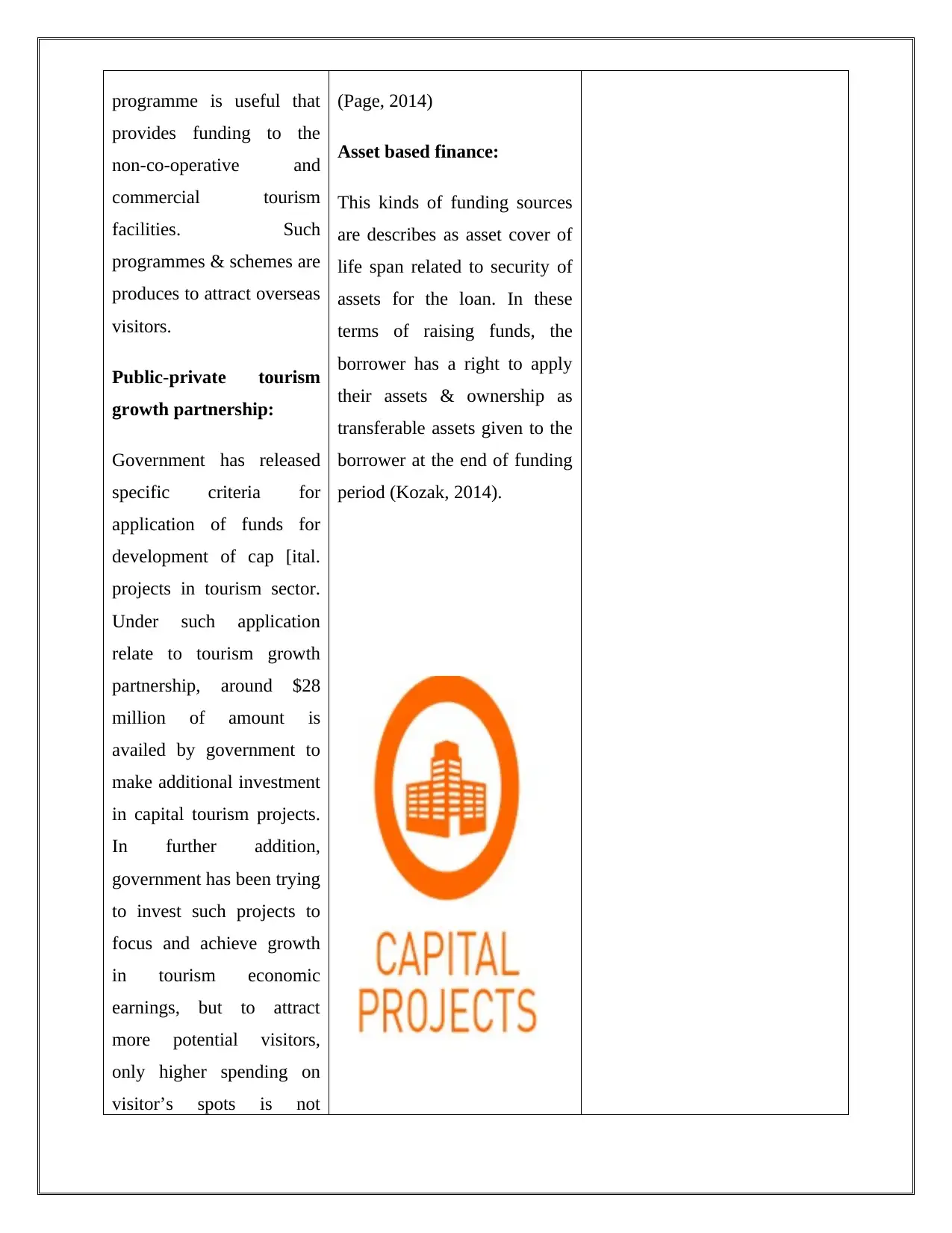
programme is useful that
provides funding to the
non-co-operative and
commercial tourism
facilities. Such
programmes & schemes are
produces to attract overseas
visitors.
Public-private tourism
growth partnership:
Government has released
specific criteria for
application of funds for
development of cap [ital.
projects in tourism sector.
Under such application
relate to tourism growth
partnership, around $28
million of amount is
availed by government to
make additional investment
in capital tourism projects.
In further addition,
government has been trying
to invest such projects to
focus and achieve growth
in tourism economic
earnings, but to attract
more potential visitors,
only higher spending on
visitor’s spots is not
(Page, 2014)
Asset based finance:
This kinds of funding sources
are describes as asset cover of
life span related to security of
assets for the loan. In these
terms of raising funds, the
borrower has a right to apply
their assets & ownership as
transferable assets given to the
borrower at the end of funding
period (Kozak, 2014).
provides funding to the
non-co-operative and
commercial tourism
facilities. Such
programmes & schemes are
produces to attract overseas
visitors.
Public-private tourism
growth partnership:
Government has released
specific criteria for
application of funds for
development of cap [ital.
projects in tourism sector.
Under such application
relate to tourism growth
partnership, around $28
million of amount is
availed by government to
make additional investment
in capital tourism projects.
In further addition,
government has been trying
to invest such projects to
focus and achieve growth
in tourism economic
earnings, but to attract
more potential visitors,
only higher spending on
visitor’s spots is not
(Page, 2014)
Asset based finance:
This kinds of funding sources
are describes as asset cover of
life span related to security of
assets for the loan. In these
terms of raising funds, the
borrower has a right to apply
their assets & ownership as
transferable assets given to the
borrower at the end of funding
period (Kozak, 2014).
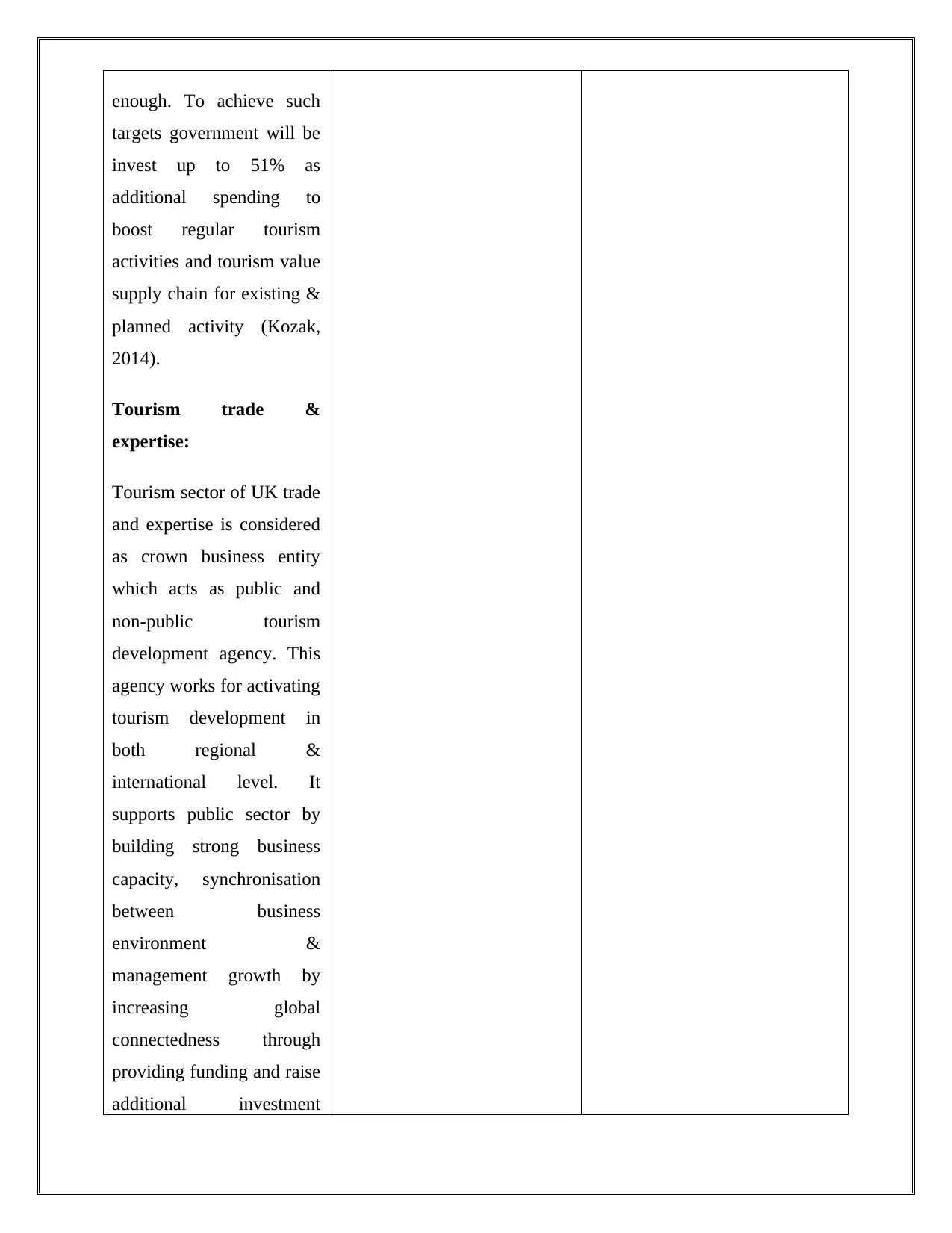
enough. To achieve such
targets government will be
invest up to 51% as
additional spending to
boost regular tourism
activities and tourism value
supply chain for existing &
planned activity (Kozak,
2014).
Tourism trade &
expertise:
Tourism sector of UK trade
and expertise is considered
as crown business entity
which acts as public and
non-public tourism
development agency. This
agency works for activating
tourism development in
both regional &
international level. It
supports public sector by
building strong business
capacity, synchronisation
between business
environment &
management growth by
increasing global
connectedness through
providing funding and raise
additional investment
targets government will be
invest up to 51% as
additional spending to
boost regular tourism
activities and tourism value
supply chain for existing &
planned activity (Kozak,
2014).
Tourism trade &
expertise:
Tourism sector of UK trade
and expertise is considered
as crown business entity
which acts as public and
non-public tourism
development agency. This
agency works for activating
tourism development in
both regional &
international level. It
supports public sector by
building strong business
capacity, synchronisation
between business
environment &
management growth by
increasing global
connectedness through
providing funding and raise
additional investment
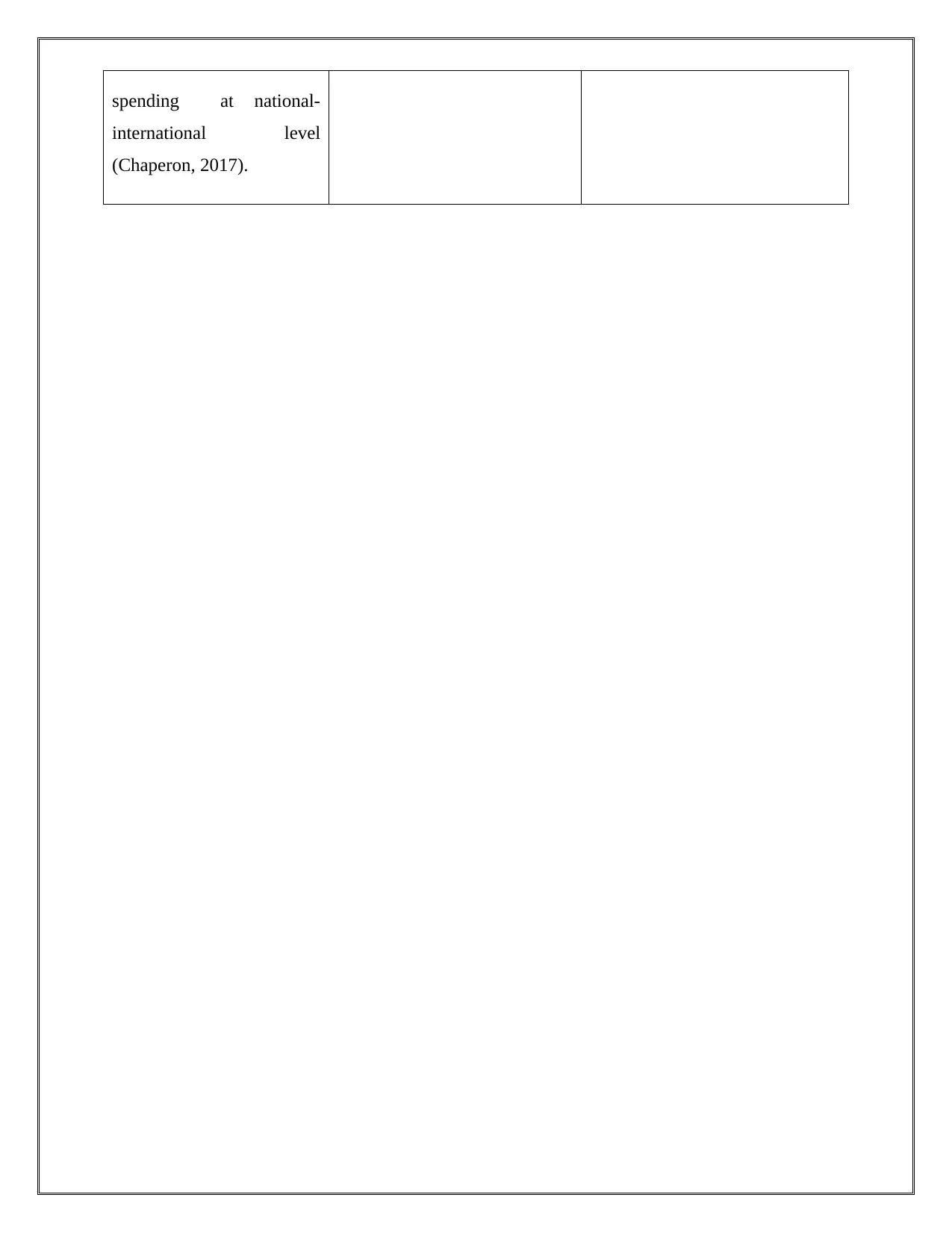
spending at national-
international level
(Chaperon, 2017).
international level
(Chaperon, 2017).
Paraphrase This Document
Need a fresh take? Get an instant paraphrase of this document with our AI Paraphraser
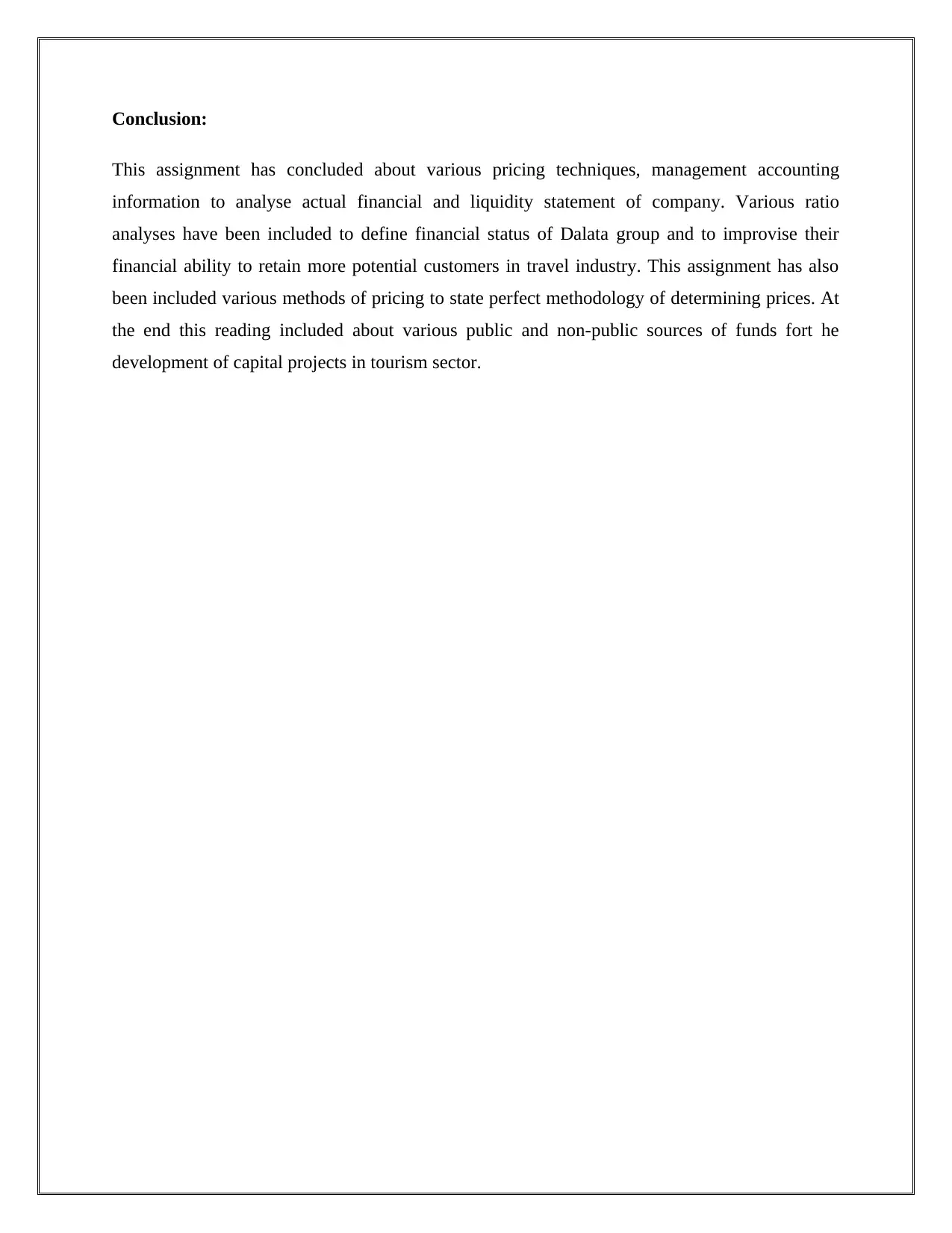
Conclusion:
This assignment has concluded about various pricing techniques, management accounting
information to analyse actual financial and liquidity statement of company. Various ratio
analyses have been included to define financial status of Dalata group and to improvise their
financial ability to retain more potential customers in travel industry. This assignment has also
been included various methods of pricing to state perfect methodology of determining prices. At
the end this reading included about various public and non-public sources of funds fort he
development of capital projects in tourism sector.
This assignment has concluded about various pricing techniques, management accounting
information to analyse actual financial and liquidity statement of company. Various ratio
analyses have been included to define financial status of Dalata group and to improvise their
financial ability to retain more potential customers in travel industry. This assignment has also
been included various methods of pricing to state perfect methodology of determining prices. At
the end this reading included about various public and non-public sources of funds fort he
development of capital projects in tourism sector.
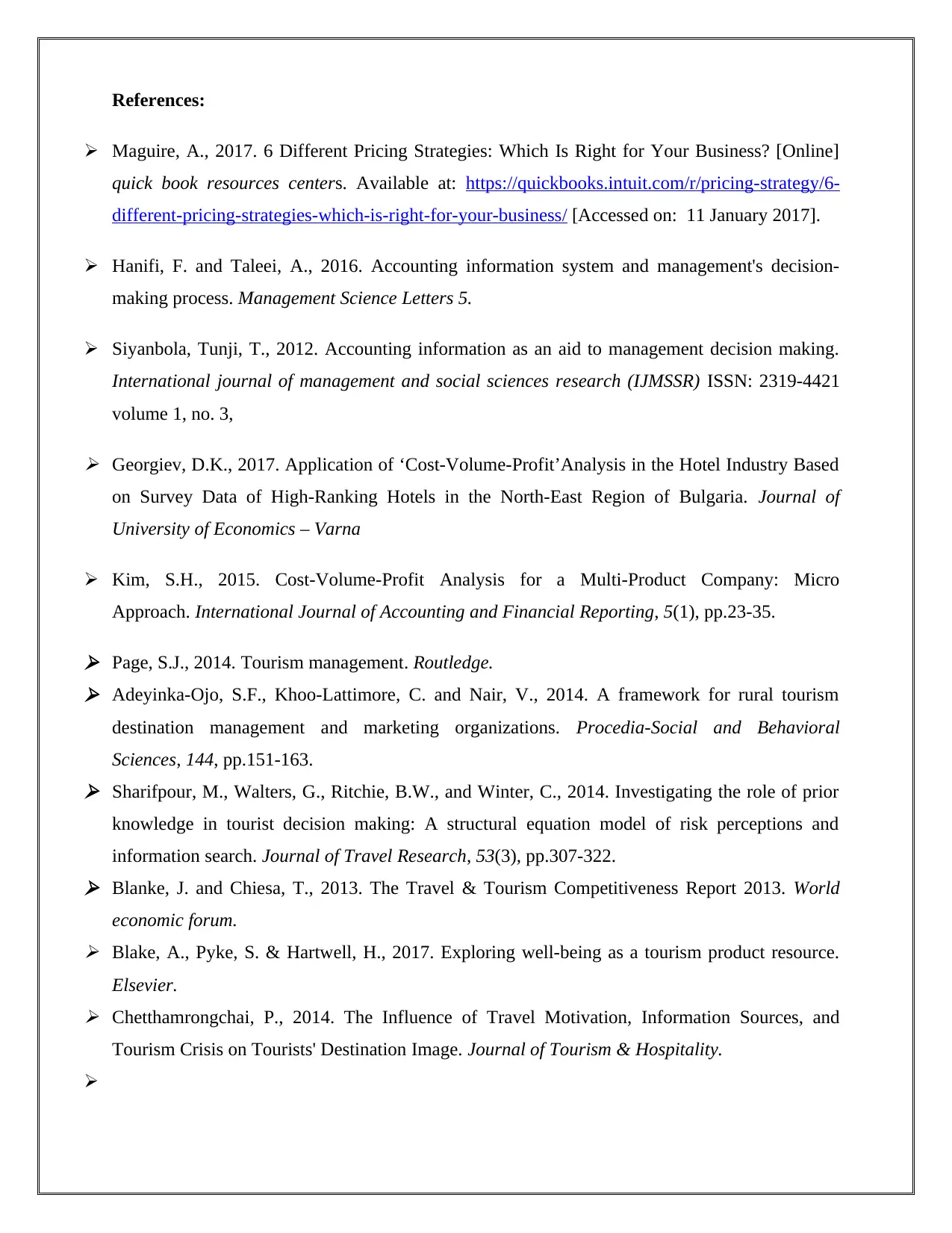
References:
Maguire, A., 2017. 6 Different Pricing Strategies: Which Is Right for Your Business? [Online]
quick book resources centers. Available at: https://quickbooks.intuit.com/r/pricing-strategy/6-
different-pricing-strategies-which-is-right-for-your-business/ [Accessed on: 11 January 2017].
Hanifi, F. and Taleei, A., 2016. Accounting information system and management's decision-
making process. Management Science Letters 5.
Siyanbola, Tunji, T., 2012. Accounting information as an aid to management decision making.
International journal of management and social sciences research (IJMSSR) ISSN: 2319-4421
volume 1, no. 3,
Georgiev, D.K., 2017. Application of ‘Cost-Volume-Profit’Analysis in the Hotel Industry Based
on Survey Data of High-Ranking Hotels in the North-East Region of Bulgaria. Journal of
University of Economics – Varna
Kim, S.H., 2015. Cost-Volume-Profit Analysis for a Multi-Product Company: Micro
Approach. International Journal of Accounting and Financial Reporting, 5(1), pp.23-35.
Page, S.J., 2014. Tourism management. Routledge.
Adeyinka-Ojo, S.F., Khoo-Lattimore, C. and Nair, V., 2014. A framework for rural tourism
destination management and marketing organizations. Procedia-Social and Behavioral
Sciences, 144, pp.151-163.
Sharifpour, M., Walters, G., Ritchie, B.W., and Winter, C., 2014. Investigating the role of prior
knowledge in tourist decision making: A structural equation model of risk perceptions and
information search. Journal of Travel Research, 53(3), pp.307-322.
Blanke, J. and Chiesa, T., 2013. The Travel & Tourism Competitiveness Report 2013. World
economic forum.
Blake, A., Pyke, S. & Hartwell, H., 2017. Exploring well-being as a tourism product resource.
Elsevier.
Chetthamrongchai, P., 2014. The Influence of Travel Motivation, Information Sources, and
Tourism Crisis on Tourists' Destination Image. Journal of Tourism & Hospitality.
Maguire, A., 2017. 6 Different Pricing Strategies: Which Is Right for Your Business? [Online]
quick book resources centers. Available at: https://quickbooks.intuit.com/r/pricing-strategy/6-
different-pricing-strategies-which-is-right-for-your-business/ [Accessed on: 11 January 2017].
Hanifi, F. and Taleei, A., 2016. Accounting information system and management's decision-
making process. Management Science Letters 5.
Siyanbola, Tunji, T., 2012. Accounting information as an aid to management decision making.
International journal of management and social sciences research (IJMSSR) ISSN: 2319-4421
volume 1, no. 3,
Georgiev, D.K., 2017. Application of ‘Cost-Volume-Profit’Analysis in the Hotel Industry Based
on Survey Data of High-Ranking Hotels in the North-East Region of Bulgaria. Journal of
University of Economics – Varna
Kim, S.H., 2015. Cost-Volume-Profit Analysis for a Multi-Product Company: Micro
Approach. International Journal of Accounting and Financial Reporting, 5(1), pp.23-35.
Page, S.J., 2014. Tourism management. Routledge.
Adeyinka-Ojo, S.F., Khoo-Lattimore, C. and Nair, V., 2014. A framework for rural tourism
destination management and marketing organizations. Procedia-Social and Behavioral
Sciences, 144, pp.151-163.
Sharifpour, M., Walters, G., Ritchie, B.W., and Winter, C., 2014. Investigating the role of prior
knowledge in tourist decision making: A structural equation model of risk perceptions and
information search. Journal of Travel Research, 53(3), pp.307-322.
Blanke, J. and Chiesa, T., 2013. The Travel & Tourism Competitiveness Report 2013. World
economic forum.
Blake, A., Pyke, S. & Hartwell, H., 2017. Exploring well-being as a tourism product resource.
Elsevier.
Chetthamrongchai, P., 2014. The Influence of Travel Motivation, Information Sources, and
Tourism Crisis on Tourists' Destination Image. Journal of Tourism & Hospitality.

Kozak, M.W., 2014. Innovation, tourism and destination development: Dolnośląskie case
study. European Planning Studies, 22(8), pp.1604-1624.
Chaperon, S., 2017. Tourism industry responses to public-private partnership arrangements for
destination management organizations in small island economies: a case study of Jersey,
Channel Islands. International Journal of Tourism Policy, 7(1), pp.23-41.
Navaneetha, B. & Punitha, K., 2017. An Analysis of Cost Volume Profit of Nestlé Limited.
Management and Administrative Sciences Review.
Kozak, M.W., 2014. Innovation, tourism and destination development: Dolnośląskie case
study. European Planning Studies, 22(8), pp.1604-1624.
Blake, A., Pyke, S. & Hartwell, H., 2017. Exploring well-being as a tourism product resource.
Elsevier.
Chetthamrongchai, P., 2014. The Influence of Travel Motivation, Information Sources, and
Tourism Crisis on Tourists' Destination Image. Journal of Tourism & Hospitality.
study. European Planning Studies, 22(8), pp.1604-1624.
Chaperon, S., 2017. Tourism industry responses to public-private partnership arrangements for
destination management organizations in small island economies: a case study of Jersey,
Channel Islands. International Journal of Tourism Policy, 7(1), pp.23-41.
Navaneetha, B. & Punitha, K., 2017. An Analysis of Cost Volume Profit of Nestlé Limited.
Management and Administrative Sciences Review.
Kozak, M.W., 2014. Innovation, tourism and destination development: Dolnośląskie case
study. European Planning Studies, 22(8), pp.1604-1624.
Blake, A., Pyke, S. & Hartwell, H., 2017. Exploring well-being as a tourism product resource.
Elsevier.
Chetthamrongchai, P., 2014. The Influence of Travel Motivation, Information Sources, and
Tourism Crisis on Tourists' Destination Image. Journal of Tourism & Hospitality.
1 out of 40
Related Documents
Your All-in-One AI-Powered Toolkit for Academic Success.
+13062052269
info@desklib.com
Available 24*7 on WhatsApp / Email
![[object Object]](/_next/static/media/star-bottom.7253800d.svg)
Unlock your academic potential
© 2024 | Zucol Services PVT LTD | All rights reserved.





